How Much Potential Do Nucleoside Analogs Offer to Combat Human Corona Viruses?
Abstract
1. Introduction
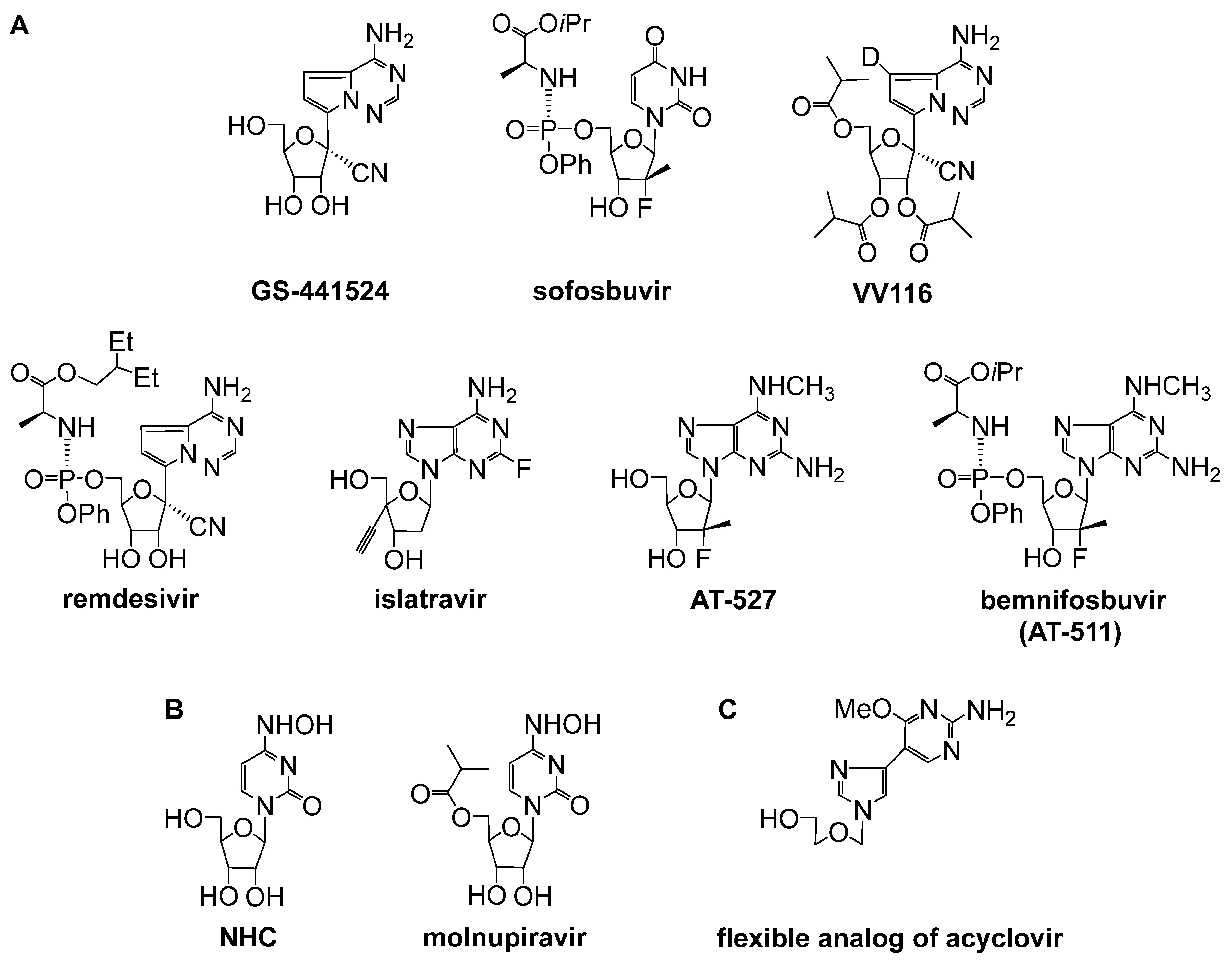
1.1. The Nucleoside Analogs Evaluated as In Vitro Inhibitors of SARS-CoV Replication
| Entry a/DRD Approach, Structure, and Number of Compounds Examined | Effective Concentration Value b; Cell Line; Virus Variant (If Given) Cytotoxic Concentration Value c; Cell Line Selectivity Index d (SI, If Given) | Ref. | ||
|---|---|---|---|---|
| 1.1/A | 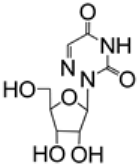 | 6-azauridine | EC50 16.8 (2.9) mg/L; Vero; FFM-1 (FFM-2) CC50 104 (18) mg/L; Vero SI 6 | [30] |
| 1.2/A |  | pyrazofurin | EC50 4.2 (0.57) mg/L; Vero; FFM-1 (FFM-2) CC50 52 (9.6) mg/L; Vero SI 12 | [30] |
| EC90 27 μM; Urbani IC90 32 μM; Vero E6 SI 1 | [31] | |||
| 1.3/A |  | R1 = H or DMTr R2 = H or OH R3 = H, OH, OMe R4 = H, Me, Br, Cl R5 = H, Bz, Ac (10 compounds) | R1,R2,R4,R5 = H, R3 = OMe: EC50 4 μM; Vero 76; Urbani IC50 23 μM; Vero 76 SI 6 | [31] |
| 1.4/A | 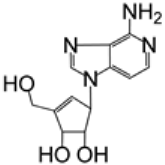 | 3-deazaneplanocin A | EC50 > 380 μM; Vero E6; Urbani IC50 > 380 μM; Vero E6 | [31] |
| IC50 > 100 μM; Urbani CC50 > 100 μM; Vero 76 | [32] | |||
| 1.5/A | 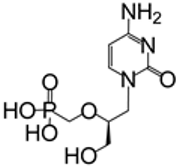 | cidofovir | EC50 > 360 μM; Vero 76; Urbani IC50 > 360 μM; Vero 76 | [31] |
| 1.6/A | 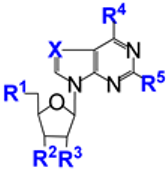 | R1, R2, R3 = H or OH R4 = OH or NH2 R5 = H or NH2 | 2′-deoxytubercidin (R1,R2 = OH, R3,R5 = H, R4 = NH2, X = CH): EC50 0.1 μM; Vero E6; Urbani IC50 0.4 μM; Vero E6 SI 4 | [31] |
| 1.7/A | 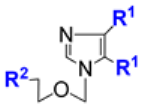 | R1 = CN, CO2H R2 = OH, OAc, OBn, Br, P(O)(OEt)2 (5 compounds) | R1 = CN, R2 = OAc: IC50 15 μg/mL; Vero CC50 56 μg/mL; Vero | [33] |
| 1.8/A | 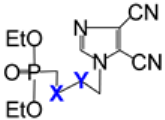 | X, Y = CH2 or O (2 compounds) | X = CH2, Y = O: IC50 23 μg/mL; Vero CC50 > 75 μg/mL; Vero | [33] |
| 1.9/A | 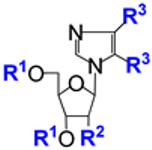 | R1 = Tol, H, Bz, Ac R2 = H, OH, OAc, OBz, R3 = CN, CO2Me, C(O)NHNH2, C(O)NH2 (7 compounds) | R1,R2 = H, R3 = CO2Me: IC50 18 μg/mL; Vero CC50 > 75 μg/mL; Vero | [33] |
| 1.10/A | 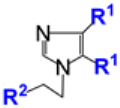 | R1 = CN, CO2H CO2Me, R2 = OH, OAc, P(O)(OH)2 (4 compounds) | R1 = CO2Me, R2 = OH: IC50 28 μg/mL; Vero CC50 > 75 μg/mL; Vero | [33] |
| 1.11/A |  | NHC | EC50 5 μM; Vero E6; Urbani IC50 50 μM; Vero E6 SI 10 | [31] |
| 1.12/A |  | ribavirin | IC50 0.1 ± 0.0 μM; Vero; Urbani CC50 12.5 ± 3.5 μM; Vero 76 SI > 125 | [32] |
| IC50 from 50 to 100 μg/mL; fRhK4; ten clinical isolates CC50 > 1000 μg/mL; fRhK4 SI from 50 to >80 | [34] | |||
| IC50 20 ± 15 μg/mL; Vero E6; Frankfurt-1 CC50 40 μg/mL; Vero E6 (2 virus variants evaluated) | [35] | |||
| IC50 210 μM; Vero 76; Urbani CC50 283 μM; Vero 76 SI 1 | [16] | |||
| IC50 0.14 μM; HAE; GFP | [36] | |||
| 1.13/A | 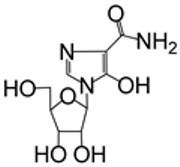 | mizoribine | IC50 3.5 ± 2.9 μg/mL; Vero E6; Frankfurt-1 CC50 > 200 μg/mL; Vero E6 (2 virus variants) | [35] |
| IC50 > 40 μM; Vero 76; Urbani CC50 > 40 μM; Vero 76 SI 0 e | [16] | |||
| IC50 13.5 μM; Vero E6; Frankfurt-1 CC50 > 700 μM; Vero E6 SI > 52 | [37] | |||
| 1.14/A |  | EICAR | IC50 > 40 μM; Vero 76; Urbani CC50 > 40 μM; Vero 76 SI 0 | [16] |
| 1.15/A | 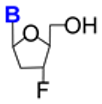 | B = 5-chlorouracil-1-yl, thymin-1-yl, cytosin-1-yl, uracil-1-yl, adenin-1-yl | B = 5-chlorouracil-1-yl: EC50 < 10 μM; Vero 76 IC50 28 μM; Vero 76 SI > 2.8 | [38] |
| 1.16/A |  | B = thymin-1-yl, cytosin-1-yl, adenin-1-yl or guanin-1-y | B = thymin-1-yl: EC50 10.3 μM; Vero 76 IC50 16.1 μM; Vero 76 SI 1.6 | [38] |
| 1.17/A |  | B = thymin-1-yl, adenin-1-yl or guanin-1-yl | B = adenin-1-yl: EC50 11.1 μM; Vero 76 IC50 3.5 μM; Vero 76 SI 0 e | [38] |
| 1.18/A |  | B = cytosin-1-yl, adenin-1-yl or thymin-1-yl | B = adenin-1-yl: EC50 11.1 μM; Vero 76 IC50 14.5 μM; Vero 76 SI 1.3 | [38] |
| 1.19/A |  | B = adenin-1-yl, thymin-1-yl or cytosin-1-yl | B = adenin-1-yl: EC50 11.9 μM; Vero 76 IC50 25.6 μM; Vero 76 SI 2.2 | [38] |
| 1.20/A |  | B = thymin-1-yl, uracil-1-yl, adenin-1-yl, inosin-1-yl or guanin-1-yl | B = thymin-1-yl: EC50 20 μM; Vero 76 IC50 > 100 μM; Vero 76 SI 5 | [38] |
| 1.21/A | 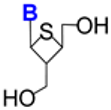 | B = uracil-1-yl, cytosin-1-yl, adenin-1-yl, inosin-1-yl or guanin-1-yl | B = cytosin-1-yl: EC50 20 μM; Vero 76 IC50 20 μM; Vero 76 SI 1 | [38] |
| 1.22/A | 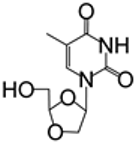 | dioxolane T (DOT) | EC50 24.5 μM; Vero 76 IC50 > 100 μM; Vero 76 SI 4.1 | [38] |
| 1.23/A |  | EC50 28.6 μM; Vero 76 IC50 > 18.8 μM; Vero 76 SI 0 | [38] | |
| 1.24/A | 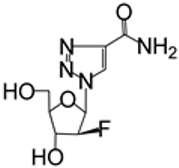 | EC50 76.8 μM; Vero 76 IC50 > 100 μM; Vero 76 SI 1.3 | [38] | |
| 1.25/A |  | B = thymin-1-yl, N-OH-cytosin-1-yl, adenin-1-yl (neplanocin A) or inosin-1-yl | EC50 > 100 μM; Vero 76 IC50 > 10 μM; Vero 76 SI 0 | [38] |
| 1.26/A |  | B = thymin-1-yl or inosin-1-yl | EC50 > 100 μM; Vero 76 IC50 > 100 μM; Vero 76 SI 0 | [38] |
| 1.27/A | 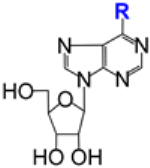 | R = OMe or SMe | IC50 > 300 μM; Vero E6; Frankfurt-1 | [37] |
| 1.28/A | 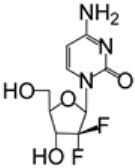 | gemcitabine | EC50 4.957 μM; Vero E6 | [39] |
| 1.29/A e |  | galidesivir (BCX4430, immucillin-A) | EC50 57.7 μM; Urbani CC50 > 296 μM; Vero 76 SI > 5.1 | [40] |
| 1.30/A | 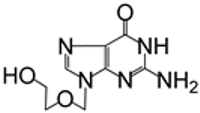 | acyclovir | EC50 > 1000 μM; Vero E6; Frankfurt-1 CC50 > 1000 μM; Vero E6 | [41] |
| 1.31/A |  | remdesivir | IC50 0.069 ± 0.036 μM CC50 > 10 μM; HAE SI > 100 | [42,43] |
| 1.32/A | 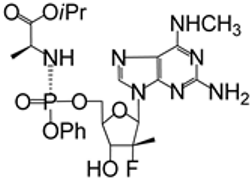 | AT-511 (bemnifosbuvir, free form of AT-527) | EC90 0.34 μM CC50 > 86 μM; Huh7 SI > 250 | [44] |
| 1.33/D | 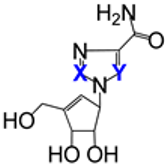 | X, Y = CH or N(3 compounds) | X = CH, Y = N: EC50 21 μM IC50 > 100 μM SI > 4.8 | [45] |
| 1.34/D | 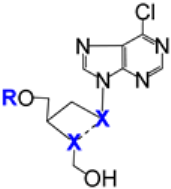 | R = H or Bz X---X = CH-CH or X = CH2 (4 compounds) | R = Bz, X---X = CH-CH: IC50 14.5 μM; Frankfurt-1 CC50 78 μM; Vero E6 SI 5.4 | [37] |
| 1.35/D | 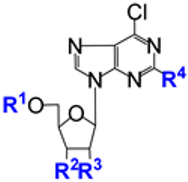 | R1 = H or Bz R2, R3 = H or OH R4 = H or NH2 (5 compounds) | R1,R2, R3 = OH, R4 = H: IC50 48.7 μM; Vero E6; Frankfurt-1 CC50 279 μM; Vero E6 SI 5.7 | [37] |
| 1.36/D | 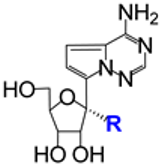 | R = Me, vinyl, ethynyl | R = vinyl: EC50 14.0 μM; Vero; Toronto-2 CC50 > 30 μM; Vero | [46] |
| 1.37/D | 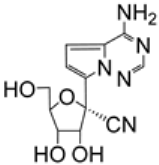 | GS-441524 | IC50 0.18 ± 0.14 μM; HAE CC50 > 100 μM; HAE | [42,43] |
| EC50 2.4 μM; Vero; Toronto-2 CC50 > 30 μM; Vero | [46] | |||
| 1.38/D e |  | X, Y = H or F B = uracil-1-yl, cytosin-1-yl N6-Me-adenin-1-yl, adenin-1-yl, R = H or  (12 compounds) (12 compounds) | X,Y = F, B = adenin-1-yl, R = H: EC50 0.5 μM; Vero E6; Frankfurt 1 CC50 5.9 μM; Vero E6 SI 11.8 | [47] |
1.2. The Nucleoside Analogs Evaluated as In Vitro Inhibitors of SARS-CoV-2 Replication
| Entry a/DRD Approach, Structure and Number of Compounds Examined | Effective Concentration Value b; Cell Line; Virus Variant (If Given) Cytotoxic Concentration Value c; Cell Line Selectivity Index d (SI, If Given) | Ref. | ||
|---|---|---|---|---|
| 2.1/A |  | NHC | IC50 0.08 μM; Calu-3 | [36] |
| EC50 0.3 ± 0.2 μM; Vero CC5012.6 μM; Vero SI 42 | [52] | |||
| 2.2/A | 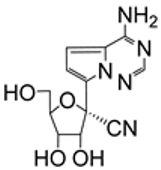 | GS-441524 | EC50 8.2 ± 0.4 μM; Vero CC50 > 100 μM; Vero SI 12 | [52] |
| EC50 0.59 ± 0.10 μM); Vero E6 CC50 > 500 μM; Vero E6 SI > 847.46 (2 virus variants evaluated) | [53] | |||
| EC50 0.10 μM; Calu-3; WA1 CC50 > 50 μM; Calu-3 SI > 524 | [54] | |||
| 2.3/A |  | remdesivir | EC50 1.0 ± 0.1 μM; Vero CC50 > 100 μM; Vero SI > 100 | [52] |
| 2.4/A |  | R1 = Me, Cl, Br R2, R3 =  or or R2 = H and R3 =  (4 compounds) | R1 = Me, R2, R3 =  : :EC50 6.3 ± 0.1 μM; Vero CC50 16.4 μM; Vero | [52] |
| 2.5/A |  | EC50 7.6 ± 0.4 μM; Vero CC50 > 100 μM; Vero SI > 10 | [52] | |
| 2.6/A | 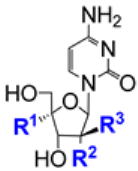 | 2′-MeC: R1 = H, R2 = OH, R3 = Me ALS-8112: R1 = CH2Cl, R2 = F, R3 = H | 2′-MeC: EC50 9.2 ± 0.1 μM; Vero CC50 > 100 μM; Vero SI > 10 | [52] |
| 2.7/A |  | entecavir | EC50 > 20 μM; Vero CC50 > 20 μM; Vero | [52] |
| 2.8/A | 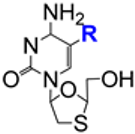 | lamivudine: R = H emtricitabine: R = F | lamivudine and emtricitabine EC50 > 20 μM; Vero CC50 > 20 μM; Vero | [52] |
| 2.9/A |  | tenofovir alafenamide: R =  tenofovir isoproxil: R = 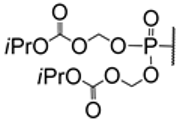 | tenofovir alafenamide and tenofovir isoproxil: EC50 > 20 μM; Vero CC50 > 20 μM; Vero | [52] |
| 2.10/A d | 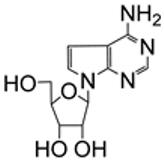 | tubercidin | EC50 0.77 μM; Vero E6 CC50 > 100 μM; Vero E6 SI 129.87 | [55] |
| EC90 0.087 μM; Caco-2; WK-521 CC50 0.66 μM; MRC5 | [56] | |||
| EC50 0.05 μM; Calu-3; WA1 CC50 9.36 μM; Calu-3 SI 190 | [54] | |||
| 2.11/A | 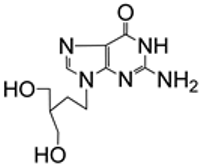 | penciclovir | EC50 95.96 μM; Vero E6 CC50 > 400 μM; Vero E6 SI 4.17 | [55] |
| 2.12/A |  | AT-511 (bemnifosbuvir, free form of AT-527) | EC90 0.47 ± 0.12 μM; HAE CC50 > 86 μM; HAE SI > 160 | [44] |
| 2.13/A e |  | galidesivir (BCX4430, immucillin-A) | EC50 14.15 μM; Calu-3; WA1/2020 CC50 > 50 μM; Calu-3 SI > 3.5 | [50] |
| 2.14/A e | 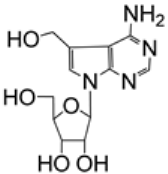 | 5-hydroxymethyltubercidin | EC90 0.57 μM; Caco-2; WK-521 CC50 > 50 μM; MRC5 | [56] |
| 2.15/A e | 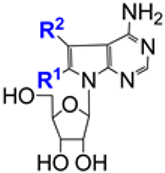 | R1 = H or CN R2 = H, CH=NOH, NO2 Me, CN (5 compounds) | R1 = H, R2 = CH=NOH: EC90 0.20 μM; Caco-2; WK-521 CC50 0.74 μM; MRC5 | [56] |
| 2.16/A e | 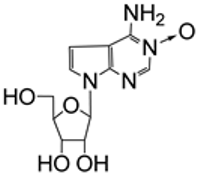 | EC90 3.5 μM Caco-2; WK-521 CC50 24 μM; MRC5 | [56] | |
| 2.17/A |  | R = H or 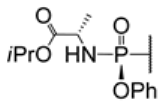 | Sofosbuvir, R =  : :EC50 5.1 ± 0.8 μM, Huh-7; clinic isolate CC50 381 ± 34 μM, Huh-7 SI 74 | [57] |
| 2.18/A |  | thioguanosine | EC50 0.04 μM; Calu-3; WA1 CC50 1.14 μM; Calu-3 SI 26 | [54] |
| IC50 0.78 µM, Caco-2; clinic isolate | [58] | |||
| 2.19/A | 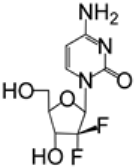 | gemcitabine | EC50 0.04 μM; Calu-3; WA1 CC50 > 20 μM; Calu-3 SI > 1235 | [54] |
| 2.20/A |  | R1 = H or OH R2 = H or NH2 (2 compounds) | 6-thioinosine (R1 = OH, R2 = H): EC50 0.05 μM; Calu-3; WA1 CC50 > 50 μM; Calu-3 SI > 1083 | [54] |
| 2.21/A |  | 3-deazaneplanocin A | IC50 579 nM; SARS-CoV-2; A549-nRFP-ACE2; SARS-CoV-2-MUC-IMB-1 (in combination with remdesivir) | [59] |
| 2.22/A e |  | sangivamycin | EC50 15.4 nM; Vero E6; B.1.1.7 (Alpha) SI 39.0 (8 virus variants evaluated) | [60] |
| 2.23/A e | 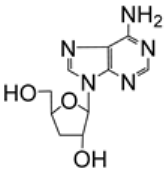 | cordycepin | EC50 2.01 ± 0.12 μM; Vero E6; VOC-202012/01 CC50 > 100 μM; Vero E6 | [61] |
| 2.24/A e | 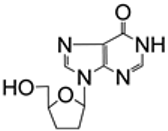 | didanosine | EC50 3.10 ± μM; Vero E6; VOC-2020/01 CC50 > 100 μM; Vero E6 | [62] |
| 2.25/A e |  | riboprine: R = 3-methylbut-2-en-1-yl tecadenoson: R = (R)-tetrahydrofuran-3-yl | riboprine: EC50 408 ± 22 nM; Vero E6; Omicron B.1.1.529/BA.5; CC50 > 100 μM; Vero E6 (3 virus variants evaluated) | [63,64,65,66] |
| 2.26/A e |  | forodesine | EC50 657 ± 34 nM; Vero E6; Omicron B.1.1.529/BA.5 CC50 > 100 μM; Vero E6 (3 virus variants evaluated) | [63,64,65,66] |
| 2.27/A e |  | maribavir | EC50 3000 ± 131 nM; Vero E6; Omicron B.1.1.529/BA.5 CC50 > 100 μM; Vero E6 (3 virus variants evaluated) | [63,64,65] |
| 2.28/A | 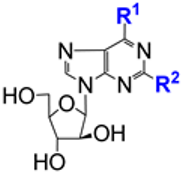 | nelarabine: R1 = OMe, R2 = NH2vidarabine: R1 = NH2, R2 = H | nelarabine: EC50 1656 ± 71 nM; Vero E6; Omicron B.1.1.529/BA.5 CC50 > 100 μM; Vero E6 (3 virus variants evaluated) | [63,64,65] |
| 2.29/A |  | 5-azacytidine | EC50 2.63 μM; Calu-3; Wuhan/WIV0 4/2019 CC50 25.40 μM; Calu-3 SI 9.66 | [67] |
| 2.30/A/B e | 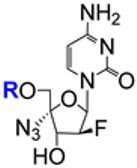 | azvudine: R = H CL-236: R =  | CL-236: EC50 1.2 μM; Calu-3; BetaCoV/Wuhan/WIV04/2019 CC50 > 102.4 μM; Calu-3 SI 83 | [68,69,70] |
| 2.31/A/D e | 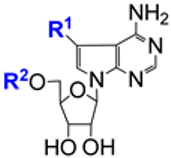 | R1 = H, R2 = furan-2-yl: EC50 0.1 ± 0.03 μM; Huh7; hCoV-19/Czech Republic/NRL_6632_2/2020 CC50 11 ± 2.5 μM; Huh7 | [71] | |
| R2 = Me, vinyl, ethynyl, cyclopropyl, furan-2-yl, thiophen-2-yl, Ph, benzofuran-2-yl, benzothiophen-2-yl, naphtalen-2-yl R2 = H,  (proTide), (proTide), 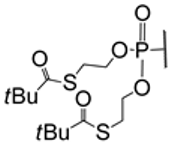 (bis(SATE), (bis(SATE),  (mono(SATE) (mono(SATE)(25 compounds) | ||||
| 2.32/B | 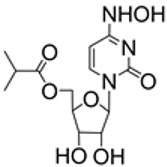 | molnupiravir | EC50 0.10 μM; Calu-3; WA1 CC50 > 50 μM; Calu-3 SI > 500 | [36,54] |
| 2.33/B e |  | R = 4-oxaicosan-1-yl, 3-oxahenicosan-1-yl, 2-OBn-4-oxadocosan-1-yl | R = 2-OBn-4-oxadocosan-1-yl: EC50 0.14 μM; Vero E6; USA-WA1/2020 CC50 97.9 μM; Vero E6 SI 699 | [72,73] |
| 2.34/B e | 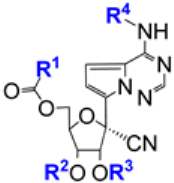 | R1 = alkyl, cycloalkyl, CF3CH2, C6H5, α-aminoalkyl R2, R3, R4 = H, acetyl, isobutyryl (21 compounds) | obeldesivir (ATV006, R1 = isopropyl; R2,R3,R4 = H): EC50 0.106 μM; Vero E6; Omicron, B.1.1.529 CC50 128.00 μM; Vero E6 SI 1207.55 (4 virus variants evaluated) | [74] |
| 2.35/B | 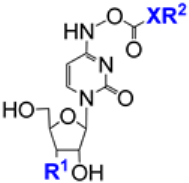 | X = O or CH2 R1 = OH or F R2 = C10H21, C12H23, C14H29 (5 compounds) | X = CH2, R = C14H29: EC50 0.31 μM; Vero; B1.1 529 BA.1 (Omicron); CC50 6.32 μM; Vero (5 virus variants evaluated) | [75] |
| 2.36/C | 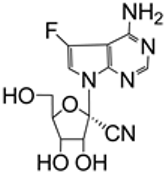 | EC50 3.30 μM; Vero E6 (2 virus strains evaluated) | [53] | |
| 2.37/C e |  | R1,R2,R3 = H or isobutyryl (4 compounds) | VV116 (R1,R2,R3 = isobutyryl; hydrobromide): EC50 0.35 ± 0.09 µM; Vero E6 CC50 289.19 ± 15.39 μM; Vero E6 (2 virus variants evaluated) | [53] |
| 2.38/C |  | EC50 29.91 μM; Vero; B1.1 529 BA.1 (Omicron); CC50 > 100 μM; Vero (5 virus variants evaluated) | [75] | |
| 2.39/D | 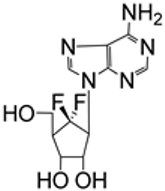 | EC50~2 μM; Calu-3 CC50 > 25 μM; Calu-3 SI > 12 μM | [47] | |
| 2.40/D | 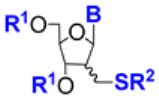 | B = thymin-1-yl, uracil-1-yl, N6-DMTr-adenin-1-yl R1 = TBDMS or (iPr)2Si-O-Si(iPr)2 R2 = C4H9, Ac, pyranos-1-yl (11 compounds) | B = thymin-1-yl, R1 = (iPr)2Si-O-Si(iPr)2, araR2 = C4H9: EC50 17 μM; Vero E6; MOI 0.05 CC50 16.6 μM; Vero E6 | [76] |
1.3. The Nucleoside Analogs Evaluated as In Vitro Inhibitors of MERS-CoV Replication
| Entry a/DRD Approach, Structure, and Number of Compounds Examined | Effective Concentration Value b; Cell Line; Virus Variant (If Given) Cytotoxic Concentration Value c; Cell Line Selectivity Index d (SI, If Given) | Ref. | ||
|---|---|---|---|---|
| 3.1/A | 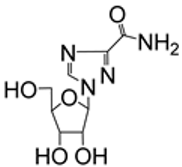 | ribavirin | IC50 9.99 ± 2.97 μg/mL; Vero CC50 > 1660 μg/mL; Vero SI > 152.98 | [81] |
| 3.2/A e | 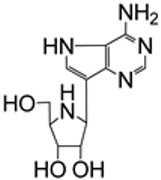 | galidesivir (BCX4430, immucillin-A) | EC50 68.4 μM; Vero E6; Jordan N3 CC50 > 100 μM; Vero E6 SI > 1.5 | [40] |
| 3.3/A | 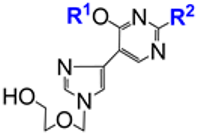 | R1 = H, Me R2 = NH2 (3 compounds) | R1 = Me, R2 = NH2: EC50 23 ± 0.6 μM; Vero; EMC/2012 CC50 71 ± 14 μM; Vero | [41] |
| 3.4/A | 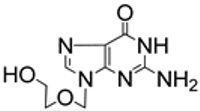 | acyclovir | EC50 > 1000 μM; Vero; EMC/2012 CC50 > 1000 μM; Vero | [41] |
| 3.5/A | 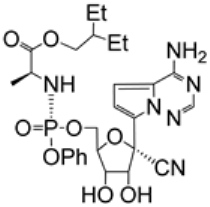 | remdesivir | EC50 0.34 μM; Vero CC50 > 20 μM; Vero | [82] |
| IC50 0.025 μM; Calu-3 CC50 > 10 μM; Calu-3 SI > 400 | [42] | |||
| IC50 0.074 ± 0.023 μM; HAE CC50 > 10 μM; HAE SI > 100 | [42,43] | |||
| 3.6/A | 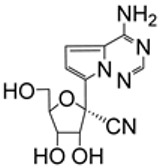 | GS-441524 | IC50 0.86 ± 0.78 μM; HAE CC50 > 100 μM; HAE | [42,43] |
| 3.7/A | 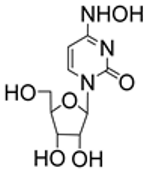 | NHC | IC50 0.56 μM; DBT-9 CC50 > 200 µM; DBT-9 | [83] |
| IC50 0.024 μM; HAE; RFP (2 virus variants evaluated) | [36] | |||
| 3.8/A | 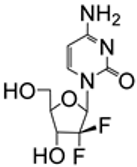 | gemcitabine | EC50 1.216 μM; Vero E6 | [39] |
| 3.9/A | 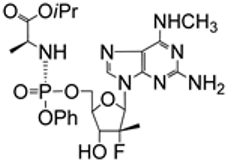 | AT-511 (bemnifosbuvir, free form of AT-527) | EC90 37 ± 28μM; Huh7 CC50 > 86 μM; Huh7 SI > 3.3 | [44] |
| 3.10/D |  | X = H or F Y = H or F B = uracil-1-yl, cytosin-1-yl, adenin-1-yl, N6-Me-adenin-1-yl, R = H or  (14 compounds) | X,Y = F, B = adenin-1-yl, R = H: EC50 0.2 μM; Vero E6; EMC/2012 CC50 3.2 μM; Vero E6 SI 16 | [47,51] |
1.4. The Nucleoside Analogs Evaluated as In Vitro Inhibitors of HCoV-OC43 Replication
| Entry a/DRD Approach, Structure, and Number of Compounds Examined | Effective Concentration Value b; Cell Line; Virus Variant (If Given) Cytotoxic Concentration Value c; Cell Line Selectivity Index d (SI, If Given) | Ref. | ||
|---|---|---|---|---|
| 4.1/A |  | remdesivir | EC50 0.04 ± 0.1 μM Huh7 CC50 2.1 μM; Huh7 SI 52 | [52] |
| 4.2/A |  | NHC | EC50 0.8 ± 0.03 μM; Huh7 CC50 80.3 μM; Huh7 SI 100 | [52] |
| 4.3/A | 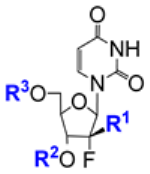 | R1 = Me, Cl, Br R2, R3 =  or R2 = H and or R2 = H andR3 =  (4 compounds) | R2 = H, R1 = Cl, R3 = 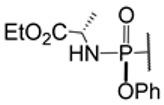 : :EC50 5.9 ± 0.6 μM; Huh7 CC50 > 100 μM; Huh7 | [52] |
| 4.4/A | 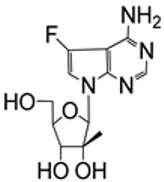 | EC50 6.7 ± 1.1 μM; Huh7 CC50 38 μM; Huh7 | [52] | |
| 4.5/A |  | 2′-MeC: R1 = H, R2 = OH, R3 = Me ALS-8112: R1 = CH2Cl, R2 = F, R3 = H | 2′-MeC: EC50 10 ± 0.7 μM; Huh7 CC50 > 100 μM; Huh7 | [52] |
| 4.6/A | 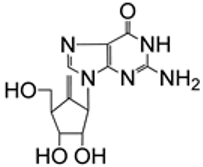 | entecavir | EC50 > 20 μM; Vero CC50 > 20 μM; Vero | [52] |
| 4.7/A |  | GS-441524 | EC50 > 10 μM; Vero CC50 13.2 ± 0.8 μM; Vero | [52] |
| 4.8/A | 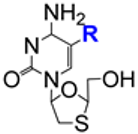 | lamivudine: R = H emtricitabine: R = F | Lamivudine and emtricitabine: EC50 > 20 μM; Vero CC50 > 20 μM; Vero | [52] |
| 4.9/A |  | tenofovir alafenamide: R =  tenofovir isoproxil: tenofovir isoproxil: R = 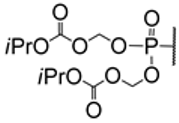 | EC50 > 20 μM; Vero CC50 > 20 μM; Vero | [52] |
| 4.10/A |  | ribavirin | EC50 20.6 μM; Huh7 CC50 22.1 μM; Huh7 | [52] |
| 4.11/A | 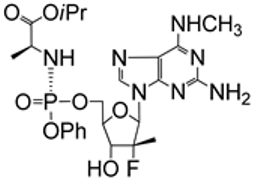 | AT-511 (bemnifosbuvir, free form of AT-527) | EC90 0.5 μM; Huh7 CC50 > 86 μM; Huh7 SI > 170 (2 virus variants evaluated) | [44] |
| 4.12/A | 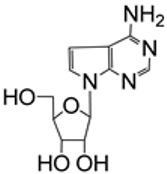 | tubercidin | EC50 0.11 μM; MRC5 CC50 0.66 μM; MRC5 | [56] |
| 4.13/A |  | 5-hydroxymethyltubercidin | EC50 0.378 ± 0.023 μM; MRC5 CC50 > 50 μM; MRC5 SI > 132 | [56] |
| 4.14/A |  | R1 = H or CN R2 = H, CH=NOH, NO2 Me, CN (5 compounds) | R1 = H, R2 = CH=NOH: EC90 0.055μM; MRC5 CC50 0.74 μM; MRC5 | [56] |
| 4.15/B | 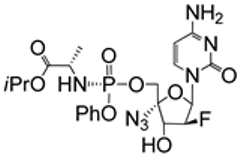 | CL-236 | EC50 1.2 μM; H460; VR1558 SI 20 | [68] |
1.5. The Nucleoside Analogs Evaluated as In Vitro Inhibitors of HCoV-229E Replication
| Entry a/DRD Approach, Structure, and Number of Compounds Examined | Effective Concentration Value b; Cell Line; Virus Variant (If Given) Cytotoxic Concentration Value c; Cell Line Selectivity Index d (SI, If Given) | Ref. | ||
|---|---|---|---|---|
| 5.1/A e | 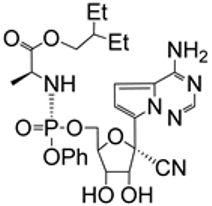 | remdesivir | EC50 0.07 μM; MRC5 TC50 > 2.0 μM; MRC5 SI > 28.6 | [84] |
| 5.2/A | 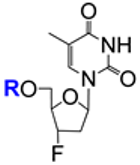 | R = H (alovudine) or CH3CH2S(CH2)11C(O)– | R = CH3CH2S(CH2)11C(O)–: EC50 > 45.4 μM; MRC5 TC50 45.4 μM; MRC5 | [84] |
| 5.3/A |  | R = H (lamivudine) or CH3(CH2)12C(O)– | R = CH3(CH2)12C(O)–: EC50 > 47.5 μM; MRC5 TC50 47.5 μM; MRC5 | [84] |
| 5.4/A | 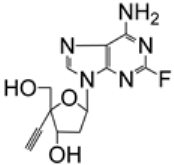 | islatravir | EC50 > 55.3 μM; MRC5 TC50 55.3 μM; MRC5 | [84] |
| 5.5/A | 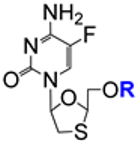 | R = H (emtricitabine) or CH3(CH2)12C(O)– | R = CH3(CH2)12C(O)–: EC50 87.5 μM; MRC5 TC50 72.8 μM; MRC5 SI 1.2 | [84] |
| 5.6/A | 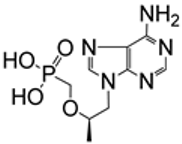 | tenofovir | EC50 > 100 μM; MRC5 TC50 > 100 μM; MRC5 | [84] |
| 5.7/A |  | AT-511 (bemnifosbuvir, free form of AT-527) | EC50 1.8 ± 0.3 μM; BHK-21 CC50 > 100 μM; BHK-21 SI > 55 (2 virus variants evaluated) | [44] |
| 5.8/A | 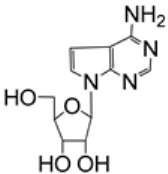 | tubercidin | EC50 < 0.078 μM; MRC5 CC50 0.66 μM; MRC5 | [56] |
| 5.9/A |  | 5-hydroxymethyltubercidin | EC50 0.528 ± 0.029 μM; MRC5 CC50 > 50 μM; MRC5 SI > 94 | [56] |
| 5.10/A | 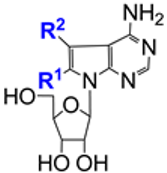 | R1 = H or CN R2 = H, CH=NOH, NO2 Me, CN(5 compounds) | R1 = H, R2 = CH=NOH: EC90 < 0.078 μM; MRC5 CC50 0.74 μM; MRC5 | [56] |
| 5.11/A | 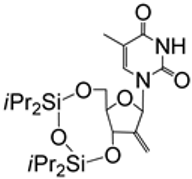 | EC50 4.0 μM; HEL CC50 10 μM; HEL | [76] | |
| 5.12/B | 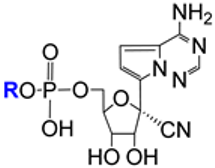 | R = 4-oxaicosan-1-yl, 3-oxahenicosan-1-yl, 2-OBn-4-oxadocosan-1-yl | R = 2-OBn-4-oxadocosan-1-yl: EC50 0.15 μM; MRC5 CC50 > 50 μM; MRC5 | [72] |
| 5.13/D | 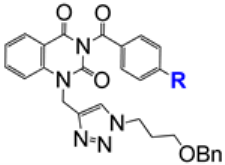 | R = H or F | R = H: EC50 18.5 ± 13.5 μM; HEL MCC > 20 μM; HEL | [85] |
| 5.14/D |  | B = thymin-1-yl, uracil-1-yl, N6-DMTr-adenin-1-yl R1 = TBDMS or (iPr)2Si-O-Si(iPr)2R2 = C4H9, Ac, pyranos-1-yl (11 compounds) | B = uracil-1-yl, R1 = (iPr)2Si-O-Si(iPr)2, araR2 = C4H9: EC50 4.1 μM; HEL CC50 10 μM; HEL | [76] |
1.6. The Nucleoside Analogs Evaluated as In Vitro Inhibitors of HCoV-NL63 Replication
| Entry a/DRD Approach, Structure, and Number of Compounds Examined | Effective Concentration Value b; Cell Line; Virus Variant (If Given) Cytotoxic Concentration Value c; Cell Line Selectivity Index d (SI, If Given) | Ref. | ||
|---|---|---|---|---|
| 6.1/A |  | R1 = H, Me R2 = NH2 (3 compounds) | R1 = Me, R2 = NH2: EC50 8.8 ± 1.5 μM; Vero 118; clinic isolate CC50 120 ± 37 μM; Vero 118 | [41] |
| 6.2/A | 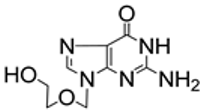 | acyclovir | EC50 > 100 μM; Vero 118; clinic isolate CC50 > 100 μM; Vero 118 | [41] |
| 6.3/A | 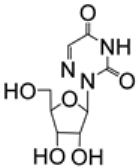 | 6-azauridine | IC50 32 nM; LLC-MK2; Amsterdam 1 CC50 80 μM; LLC-MK2 SI 2500 | [86] |
| 6.4/A | 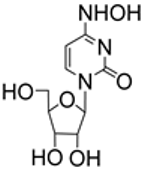 | NHC | IC50 400 nM; LLC-MK2; Amsterdam 1 CC50 > 100 μM; LLC-MK2 SI > 250 | [86] |
1.7. The Nucleoside Analogs Evaluated as Inhibitors of HCoV-Related Enzymes
| Entry a/DRD Approach, Structure and Number of Compounds Examined | Object of Study b Antiviral Effect(s) If Given c | Ref. | ||
|---|---|---|---|---|
| 7.1/A |  | X = S or (S)-CH-NH2 n = 1 or 2 (3 compounds) | Inhibition of SARS-CoV nsp14 and SARS-CoV nsp16–nsp10 complex sinefungin (X = (S)-CH-NH2, n = 2): IC50 496 nM ± 18, nsp14 IC50 736 nM ± 71; nsp16/nsp10 AdoHcy (X = S, n = 2): IC50 16 µM ± 1.2, nsp14 IC50 12 µM ± 1.9, nsp16/nsp10 | [87,88] |
 | X = N or N+–Me Y = N or CH R1 = OH, SMe, SiBu, –O[P(O)(OH)O]3H R2 = H or Ac R3 = H or NH2 (6 compounds) | |||
 | X = N or C-C≡CH R = H or –[P(O)(OH)O]3H (3 compounds) | |||
| 7.2/A |  | X = S (AdoHcy) or (S)-CH-NH2 (sinefungin) | Inhibition of MERS-CoV nsp16–nsp10 complex AdoHcy: IC50 7 µM ± 0.4 sinefungin: IC50 7.4 μM ± 0.9 | [88,89] |
| 7.3/A |  R1 = H, OH, Me, F R2 = H, OH, Me B = cytosin-1-yl, uracil-1-yl, adenin-9-yl, 3-carbamoyl-5-fluoro-2-oxopyrazin-1-yl, 3-carbamoyl-1H-1,2,4-triazol-1-yl (7 compounds) | Selectivity of the SARS-CoV-2 RdRp towards incorporation of the nucleoside analog triphosphate into viral RNA over a natural nucleotide. Low discrimination of the enzyme against the cytidine triphosphate derivative (B = cytosin-1-yl, R1 = F, R2 = H) over the reference cytidine triphosphate | [89,90] | |
| 7.4/A | 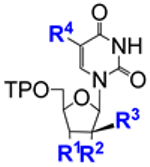 | R1 = OH, N3, F R2 = H or F R3 = H or Me R4 = H or Me (3 compounds) | Proclivity of SARS-CoV RdRp or SARS-CoV-2 RdRp to incorporate the nucleoside triphosphate into the virus RNA Sofosbuvir nucleoside triphosphate (R1 = OH, R2 = F, R3 = Me, R4 = H) was incorporated by the RdRp, terminated the polymerase reaction and was resistant to SARS-CoV-2 proofreader | [90,91,92,93] |
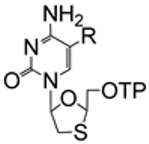 | triphosphate of lamivudine (R = H) or emtricitabine (R = F) | |||
 | carbovir triphosphate | |||
| 7.5/A |  | GS-441524 triphosphate | Incorporation of nucleotide analogs to viral RNA by SARS-CoV-2 RdRp The incorporation of GS-441524 triphosphate and delay in viral RNA chain termination | [93,94] |
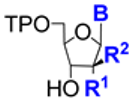 R1 = F, OH, NH2, H, OMe R2 = F, H, Me, OH, N3 B = cytosin-1-yl, uracil-1-yl, purin-9-yl (6-Cl-; 6-NH2,2-Cl; 6-SMe,2-NH2; 6-SH,2- NH2), guanin-9-yl, 8-oksoguanin-9-yl, 3-carbamoyl-1H-1,2,4-triazol-1-yl, 3-carbamoyl-5-fluoro-2-oxopyrazin-1-yl (15 compounds) | ||||
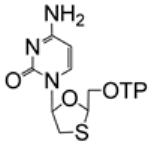 | lamivudine triphosphate | |||
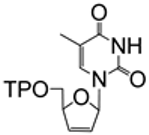 | stavudine triphosphate | |||
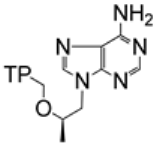 | tenofovir triphosphate | |||
| 7.6/A d | 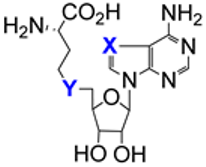 | X = N or C-CN Y = S, (S)-CHCH2NH2, N-CH2CH2C6H4-C(O)NH2-3 (4 compounds) | Inhibition of SARS-CoV-2 nsp14, SARS-CoV-2 nsp10–nsp16 complex from SARS-CoV, SARS-CoV-2, HCoV-OC43, HCoV-HKU1, HCoV-NL63, HCoV-229E, and MERS-CoV and selectivity against 20 human protein lysine methyltransferases Compound SS148 (X = C-CN, Y = S): IC50 0.07 ± 0.006 µM; SARS-CoV-2 nsp14 IC50 0.2 ± 0.04 µM; HCoV-NL63 nsp10–nsp16 complex Compound WZ16 (X = N, Y = (S)-CH-CH2NH2): IC50 0.19 ± 0.04 µM; SARS-CoV-2 nsp14 IC50 2.5 ± 0.1 µM; SARS-CoV nsp10–nsp16 complex | [94,95,96] |
 | ||||
 | R = -CH2-CH2-C6H5 (DS0464) or -CH2-c-C6H11 | |||
| 7.7/A d | 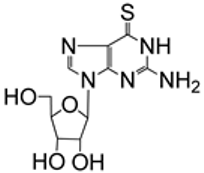 | thioguanosine | The inhibitory effect on SARS-CoV-2 3CL-Pro IC50 6.3 μM; SARS-CoV-2 3CL-Pro IC50 3.9 μM; SARS-CoV-2; Vero E6 CC50 > 20, Vero E6 | [97] |
| 7.8/A d |  | EIDD-2749 | Inhibition of SARS-CoV-2 RdRp EC50 2.47 μM; HAE; USA-WA1/2020 CC50 467.9 μM; HAE | [98] |
| 7.9/A d |  | R1 = H or –[P(O)(OH)O]3H R2,R3 = H or OH R4 = SH or NH2 R5 = NH2, F or H X = N or C-I (4 compounds) | Inhibition of SARS-CoV-2 RdRp R1,R3,R5 = H, R2 = OH, R4 = NH2, X = C-I EC50 0.75 μM; SARS-CoV-2 RdRp CC50 59.46 μM; HEK 293T EC50 1.56 μM; HCoV-OC43; HCT-8 EC50 3.62 μM; HCoV-NL63; LLCM-K2 | [99] |
| 7.10/A d |  | sinefungin | Disruption of WT SARS-CoV-2 nsp16 activity | [100] |
| 7.11/D d |  R = H, (S)-3-NH2-4-CO2H-prop-1-yl, alkyl, substituted benzyl or benzenesulfonyl (16 compounds) | Inhibition of SARS-CoV nsp14 R = –S(O)2-C6H3-3-NO2,4-Cl: IC50 0.6 ± 0.1 µM | [101] | |
| 7.12/D d |  Ar = Ph, naphtyl, guinolin-3-yl, benzimidazol-2-yl, benzo[b]thiophen-5-yl X = CH2, –CH2–CH2–, –C≡C– (8 compounds) | Inhibition of SARS-CoV nsp14 R = guinolin-3-yl: IC50 3 ± 0.5 nM | [102] | |
| 7.13/D d | 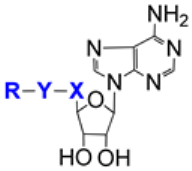 | X = CH2 or C(O) Y = S, NH, N(3°), 1,2,3-triazole, piperazine R = substituted alkyl, aryl, benzyl (36 compounds) | Inhibition of SARS-CoV-2 nsp14, SARS-CoV-2 nsp16–nsp10 complex or hGNMT X = CH2, Y = S, R = CH2-C6H3-3-CO2H,5-Ph: IC50 0.58 ± 0.03 nM; nsp14 X = CH2 Y = S, R = CH2-C6H3-3-CO2H: IC50 4 ± 0.5 nM; nsp16/nsp10 | [103,104] |
| 7.14/D d | 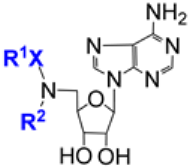 | X = S(O)2, C(O) R1 = substituted phenyl R2 = H, Et, alkyl (39 compounds) | Inhibition of SARS-CoV-2 nsp14 X = S(O)2, R1 = C6H3-3-CN,4-OMe, R2 = Et: IC50 0.019 µM | [105] |
| 7.15/D |  | R = NO2, NH2, CF3, Me, Cl, NHAc n = 1 or 2 (20 compounds) | Inhibition of SARS-CoV-2 nsp14 R = 4-NO2, n = 1: 40% inhibition of SARS-CoV-2 nsp14 at the compound concentration of 5 µM | [106] |
| 7.16/D d | 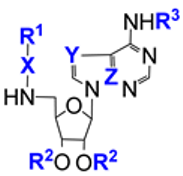 | R2 = H, Ac, isobutyryl R3 = H or Ac X = CH2, C(O), S(O)2 Y = N or CH Z = C or N R1 = napht-2-yl, quinolin-7-yl, 2-Cl-quinolin-6-yl (11 compounds) | Inhibition of SARS-CoV-2 nsp14 X = S(O)2, Y = CH, Z = N, R1 = napht-2-yl, R2 = H, R3 = H: IC50 0.093 µM; nsp14 EC50 0.72 µM; SARS-CoV-2; A459 AT CC50 > 100 µM; A459 AT | [107] |
| 7.17/D d | 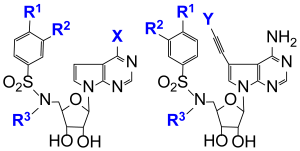 R1 = Br, Me, OMe; R2 = Cl, NO2, CN; R3 = H, Me, Et; X = OH or NHMe; Y = Ph or quinolin-3-yl (26 compounds) | Inhibition of SARS-CoV nsp14, SARS-CoV-2 nsp14, MERS-CoV nsp14 R1 = OMe, R2 = CN, R3 = Me, Y = quinolin-3-yl: IC50 0.141 ± 0.02 nM; SARS-CoV nsp14 IC50 0.72 ± 0.4 nM; SARS-CoV-2 nsp14 R1 = OMe, R2 = CN, R3 = Me, Y = Ph: IC50 1.25 ± 0.25 nM; MERS-CoV nsp14 | [108] | |
2. Conclusions
Author Contributions
Funding
Data Availability Statement
Conflicts of Interest
Abbreviations
| 3CL-Pro | 3C-like protease |
| A459 cells | adenocarcinomic human alveolar basal epithelial cells |
| ATP | adenosine triphosphate |
| BHK-21 cells | baby hamster kidney fibroblast cells |
| Calu-3 cells | human lung cells |
| Caco-2 cells | human colorectal adenocarcinoma cells |
| CC50 | 50% cytotoxic concentration |
| DBT-9 cells | delayed brain tumor, murine astrocytoma clone 9 |
| DMTr | dimethoxytrityl |
| EC50 | 50% effective concentration |
| fRhK4 cells | fetal rhesus monkey kidney cells |
| H460 cells | human nonsmall cell lung cancer cells |
| HAE cells | human tracheobronchial epithelial cells |
| HCT-8 cells | human ileocecal adenocarcinoma cells |
| HEK 293T cells | human embryonic kidney cells |
| HEL cells | human embryonic lung cells |
| Huh7 cells | well differentiated hepatocyte-derived carcinoma cells |
| HSV-1 | herpes simplex virus 1 |
| HSV-2 | herpes simplex virus 2 |
| IC50 | 50% cytotoxic concentration |
| IFN-I | Interferon type I |
| KD | protein–ligand dissociation constant |
| LLC-MK2 cells | rhesus monkey kidney epithelial cells |
| MCC cells | Merkel cell carcinoma |
| MRC-5 cells | human fetal lung fibroblast cells |
| nsp14 | RNA cap guanine-N7-methyltransferase |
| nsp16–nsp10 | 2′-O-methyltransferase nsp16–nsp10 complex |
| RD cells | rhabdomyosarcoma cells |
| RdRp | RNA-dependent RNA polymerase |
| SAH | S-adenosyl-L-homocysteine |
| SAM | S-adenosyl-L-methionine |
| SCC-VII | squamous cell carcinoma |
| TBDMS | tert-butyldimethylsilyl |
| TC50 | 50% toxic concentration |
| TP | –[P(O)(OH)O]3H |
| Vero cells | Green Monkey kidney epithelial cells |
| Vero 118 cells | Vero cells clone 118 |
| Vero 76 cells | Vero cells clone 76 |
| Vero E6 cells | Vero cells clone E6 |
| Vero E6 TMPRSS2 cells | human transmembrane serine protease 2-expressing Vero E6 cells |
References
- Weiss, S.R. Forty Years with Coronaviruses. J. Exp. Med. 2020, 217, e20200537. [Google Scholar] [CrossRef]
- Guarner, J. Three Emerging Coronaviruses in Two Decades. Am. J. Clin. Pathol. 2020, 153, 420–421. [Google Scholar] [CrossRef]
- WHO Regional Office for the Western Pacific. SARS: How a Global Epidemic Was Stopped; WHO Regional Office for the Western Pacific: Manila, Philippines, 2006; ISBN 978-92-9061-213-1. [Google Scholar]
- Azhar, E.I.; Hui, D.S.C.; Memish, Z.A.; Drosten, C.; Zumla, A. The Middle East Respiratory Syndrome (MERS). Infect. Dis. Clin. N. Am. 2019, 33, 891–905. [Google Scholar] [CrossRef]
- Middle East Respiratory Syndrome Coronavirus (MERS-CoV). Available online: https://www.who.int/health-topics/middle-east-respiratory-syndrome-coronavirus-mers (accessed on 5 June 2023).
- Weekly Epidemiological Update on COVID-19—1 June 2023. Available online: https://www.who.int/publications/m/item/weekly-epidemiological-update-on-covid-19---1-june-2023 (accessed on 5 June 2023).
- WHO Chief Declares End to COVID-19 as a Global Health Emergency|UN News. Available online: https://news.un.org/en/story/2023/05/1136367 (accessed on 5 June 2023).
- Marra, M.A.; Jones, S.J.M.; Astell, C.R.; Holt, R.A.; Brooks-Wilson, A.; Butterfield, Y.S.N.; Khattra, J.; Asano, J.K.; Barber, S.A.; Chan, S.Y.; et al. The Genome Sequence of the SARS-Associated Coronavirus. Science 2003, 300, 1399–1404. [Google Scholar] [CrossRef]
- Kandeil, A.; Shehata, M.M.; El Shesheny, R.; Gomaa, M.R.; Ali, M.A.; Kayali, G. Complete Genome Sequence of Middle East Respiratory Syndrome Coronavirus Isolated from a Dromedary Camel in Egypt. Genome Announc. 2016, 4, e00309-16. [Google Scholar] [CrossRef]
- Naqvi, A.A.T.; Fatima, K.; Mohammad, T.; Fatima, U.; Singh, I.K.; Singh, A.; Atif, S.M.; Hariprasad, G.; Hasan, G.M.; Hassan, M.d.I. Insights into SARS-CoV-2 Genome, Structure, Evolution, Pathogenesis and Therapies: Structural Genomics Approach. Biochim. Biophys. Acta BBA Mol. Basis Dis. 2020, 1866, 165878. [Google Scholar] [CrossRef]
- Morse, J.S.; Lalonde, T.; Xu, S.; Liu, W.R. Learning from the Past: Possible Urgent Prevention and Treatment Options for Severe Acute Respiratory Infections Caused by 2019-nCoV. ChemBioChem 2020, 21, 730–738. [Google Scholar] [CrossRef]
- Li, G.; De Clercq, E. Therapeutic Options for the 2019 Novel Coronavirus (2019-nCoV). Nat. Rev. Drug Discov. 2020, 19, 149–150. [Google Scholar] [CrossRef]
- Martinez, M.A. Compounds with Therapeutic Potential against Novel Respiratory 2019 Coronavirus. Antimicrob. Agents Chemother. 2020, 64, e00399-20. [Google Scholar] [CrossRef]
- Pastuch-Gawołek, G.; Gillner, D.; Król, E.; Walczak, K.; Wandzik, I. Selected Nucleos(t)Ide-Based Prescribed Drugs and Their Multi-Target Activity. Eur. J. Pharmacol. 2019, 865, 172747. [Google Scholar] [CrossRef]
- Koren, G.; King, S.; Knowles, S.; Phillips, E. Ribavirin in the Treatment of SARS: A New Trick for an Old Drug? CMAJ Can. Med. Assoc. J. 2003, 168, 1289–1292. [Google Scholar]
- Barnard, D.L.; Day, C.W.; Bailey, K.; Heiner, M.; Montgomery, R.; Lauridsen, L.; Winslow, S.; Hoopes, J.; Li, J.K.-K.; Lee, J.; et al. Enhancement of the Infectivity of SARS-CoV in BALB/c Mice by IMP Dehydrogenase Inhibitors, Including Ribavirin. Antivir. Res. 2006, 71, 53–63. [Google Scholar] [CrossRef]
- Li, G.; Hilgenfeld, R.; Whitley, R.; De Clercq, E. Therapeutic Strategies for COVID-19: Progress and Lessons Learned. Nat. Rev. Drug Discov. 2023, 22, 449–475. [Google Scholar] [CrossRef]
- Horga, A.; Kuritzkes, D.R.; Kowalczyk, J.J.; Pietropaolo, K.; Belanger, B.; Lin, K.; Perkins, K.; Hammond, J. Phase II Study of Bemnifosbuvir in High-Risk Participants in a Hospital Setting with Moderate COVID-19. Future Virol. 2023, 18, 489–500. [Google Scholar] [CrossRef]
- Jordan, P.C.; Stevens, S.K.; Deval, J. Nucleosides for the Treatment of Respiratory RNA Virus Infections. Antivir. Chem. Chemother. 2018, 26, 1–19. [Google Scholar] [CrossRef]
- Pruijssers, A.J.; Denison, M.R. Nucleoside Analogues for the Treatment of Coronavirus Infections. Curr. Opin. Virol. 2019, 35, 57–62. [Google Scholar] [CrossRef]
- Totura, A.L.; Bavari, S. Broad-Spectrum Coronavirus Antiviral Drug Discovery. Expert Opin. Drug Discov. 2019, 14, 397–412. [Google Scholar] [CrossRef]
- Yan, J.; Liu, A.; Huang, J.; Wu, J.; Fan, H. Research Progress of Drug Treatment in Novel Coronavirus Pneumonia. AAPS PharmSciTech 2020, 21, 130. [Google Scholar] [CrossRef]
- Ami, E.; Ohrui, H. Intriguing Antiviral Modified Nucleosides: A Retrospective View into the Future Treatment of COVID-19. ACS Med. Chem. Lett. 2021, 12, 510–517. [Google Scholar] [CrossRef]
- Roy, V.; Agrofoglio, L.A. Nucleosides and Emerging Viruses: A New Story. Drug Discov. Today 2022, 27, 1945–1953. [Google Scholar] [CrossRef]
- Borbone, N.; Piccialli, G.; Roviello, G.N.; Oliviero, G. Nucleoside Analogs and Nucleoside Precursors as Drugs in the Fight against SARS-CoV-2 and Other Coronaviruses. Molecules 2021, 26, 986. [Google Scholar] [CrossRef]
- Thames, J.E.; Seley-Radtke, K.L. Comparison of the Old and New—Novel Mechanisms of Action for Anti-Coronavirus Nucleoside Analogues. CHIMIA 2022, 76, 409–417. [Google Scholar] [CrossRef]
- Xu, X.; Chen, Y.; Lu, X.; Zhang, W.; Fang, W.; Yuan, L.; Wang, X. An Update on Inhibitors Targeting RNA-Dependent RNA Polymerase for COVID-19 Treatment: Promises and Challenges. Biochem. Pharmacol. 2022, 205, 115279. [Google Scholar] [CrossRef]
- Bekheit, M.S.; Panda, S.S.; Girgis, A.S. Potential RNA-Dependent RNA Polymerase (RdRp) Inhibitors as Prospective Drug Candidates for SARS-CoV-2. Eur. J. Med. Chem. 2023, 252, 115292. [Google Scholar] [CrossRef]
- Zenchenko, A.A.; Drenichev, M.S.; Mikhailov, S.N. Nucleoside Inhibitors of Coronaviruses. Curr. Med. Chem. 2021, 28, 5284–5310. [Google Scholar] [CrossRef]
- Cinatl, J.; Morgenstern, B.; Bauer, G.; Chandra, P.; Rabenau, H.; Doerr, H.W. Glycyrrhizin, an Active Component of Liquorice Roots, and Replication of SARS-Associated Coronavirus. Lancet 2003, 361, 2045–2046. [Google Scholar] [CrossRef]
- Barnard, D.L.; Hubbard, V.D.; Burton, J.; Smee, D.F.; Morrey, J.D.; Otto, M.J.; Sidwell, R.W. Inhibition of Severe Acute Respiratory Syndrome-Associated Coronavirus (SARSCoV) by Calpain Inhibitors and Beta-D-N4-Hydroxycytidine. Antivir. Chem. Chemother. 2004, 15, 15–22. [Google Scholar] [CrossRef]
- Barnard, D.L.; Day, C.W.; Bailey, K.; Heiner, M.; Montgomery, R.; Lauridsen, L.; Chan, P.K.; Sidwell, R.W. Evaluation of Immunomodulators, Interferons and Known in Vitro SARS-CoV Inhibitors for Inhibition of SARS-Cov Replication in BALB/c Mice. Antivir. Chem. Chemother. 2006, 17, 275–284. [Google Scholar] [CrossRef]
- Günther, S.; Asper, M.; Röser, C.; Luna, L.K.S.; Drosten, C.; Becker-Ziaja, B.; Borowski, P.; Chen, H.-M.; Hosmane, R.S. Application of Real-Time PCR for Testing Antiviral Compounds against Lassa Virus, SARS Coronavirus and Ebola Virus in Vitro. Antivir. Res. 2004, 63, 209–215. [Google Scholar] [CrossRef]
- Chen, F.; Chan, K.H.; Jiang, Y.; Kao, R.Y.T.; Lu, H.T.; Fan, K.W.; Cheng, V.C.C.; Tsui, W.H.W.; Hung, I.F.N.; Lee, T.S.W.; et al. In Vitro Susceptibility of 10 Clinical Isolates of SARS Coronavirus to Selected Antiviral Compounds. J. Clin. Virol. 2004, 31, 69–75. [Google Scholar] [CrossRef]
- Saijo, M.; Morikawa, S.; Fukushi, S.; Mizutani, T.; Hasegawa, H.; Nagata, N.; Iwata, N.; Kurane, I. Inhibitory Effect of Mizoribine and Ribavirin on the Replication of Severe Acute Respiratory Syndrome (SARS)-Associated Coronavirus. Antivir. Res. 2005, 66, 159–163. [Google Scholar] [CrossRef]
- Sheahan, T.P.; Sims, A.C.; Zhou, S.; Graham, R.L.; Pruijssers, A.J.; Agostini, M.L.; Leist, S.R.; Schäfer, A.; Dinnon, K.H.; Stevens, L.J.; et al. An Orally Bioavailable Broad-Spectrum Antiviral Inhibits SARS-CoV-2 in Human Airway Epithelial Cell Cultures and Multiple Coronaviruses in Mice. Sci. Transl. Med. 2020, 12, eabb5883. [Google Scholar] [CrossRef]
- Ikejiri, M.; Saijo, M.; Morikawa, S.; Fukushi, S.; Mizutani, T.; Kurane, I.; Maruyama, T. Synthesis and Biological Evaluation of Nucleoside Analogues Having 6-Chloropurine as Anti-SARS-CoV Agents. Bioorganic Med. Chem. Lett. 2007, 17, 2470–2473. [Google Scholar] [CrossRef]
- Chu, C.K.; Gadthula, S.; Chen, X.; Choo, H.; Olgen, S.; Barnard, D.L.; Sidwell, R.W. Antiviral Activity of Nucleoside Analogues against SARS-Coronavirus (SARS-CoV). Antivir. Chem. Chemother. 2006, 17, 285–289. [Google Scholar] [CrossRef]
- Dyall, J.; Coleman, C.M.; Hart, B.J.; Venkataraman, T.; Holbrook, M.R.; Kindrachuk, J.; Johnson, R.F.; Olinger, G.G.; Jahrling, P.B.; Laidlaw, M.; et al. Repurposing of Clinically Developed Drugs for Treatment of Middle East Respiratory Syndrome Coronavirus Infection. Antimicrob. Agents Chemother. 2014, 58, 4885–4893. [Google Scholar] [CrossRef]
- Warren, T.K.; Wells, J.; Panchal, R.G.; Stuthman, K.S.; Garza, N.L.; Van Tongeren, S.A.; Dong, L.; Retterer, C.J.; Eaton, B.P.; Pegoraro, G.; et al. Protection against Filovirus Diseases by a Novel Broad-Spectrum Nucleoside Analogue BCX4430. Nature 2014, 508, 402–405. [Google Scholar] [CrossRef]
- Peters, H.L.; Jochmans, D.; de Wilde, A.H.; Posthuma, C.C.; Snijder, E.J.; Neyts, J.; Seley-Radtke, K.L. Design, Synthesis and Evaluation of a Series of Acyclic Fleximer Nucleoside Analogues with Anti-Coronavirus Activity. Bioorganic Med. Chem. Lett. 2015, 25, 2923–2926. [Google Scholar] [CrossRef]
- Sheahan, T.P.; Sims, A.C.; Graham, R.L.; Menachery, V.D.; Gralinski, L.E.; Case, J.B.; Leist, S.R.; Pyrc, K.; Feng, J.Y.; Trantcheva, I.; et al. Broad-Spectrum Antiviral GS-5734 Inhibits Both Epidemic and Zoonotic Coronaviruses. Sci. Transl. Med. 2017, 9, eaal3653. [Google Scholar] [CrossRef]
- Agostini, M.L.; Andres, E.L.; Sims, A.C.; Graham, R.L.; Sheahan, T.P.; Lu, X.; Smith, E.C.; Case, J.B.; Feng, J.Y.; Jordan, R.; et al. Coronavirus Susceptibility to the Antiviral Remdesivir (GS-5734) Is Mediated by the Viral Polymerase and the Proofreading Exoribonuclease. mBio 2018, 9, e00221-18. [Google Scholar] [CrossRef]
- Good, S.S.; Westover, J.; Jung, K.H.; Zhou, X.-J.; Moussa, A.; La Colla, P.; Collu, G.; Canard, B.; Sommadossi, J.-P. AT-527, a Double Prodrug of a Guanosine Nucleotide Analog, Is a Potent Inhibitor of SARS-CoV-2 In Vitro and a Promising Oral Antiviral for Treatment of COVID-19. Antimicrob. Agents Chemother. 2021, 65, aac.02479-20. [Google Scholar] [CrossRef]
- Cho, J.H.; Bernard, D.L.; Sidwell, R.W.; Kern, E.R.; Chu, C.K. Synthesis of Cyclopentenyl Carbocyclic Nucleosides as Potential Antiviral Agents Against Orthopoxviruses and SARS. J. Med. Chem. 2006, 49, 1140–1148. [Google Scholar] [CrossRef]
- Cho, A.; Saunders, O.L.; Butler, T.; Zhang, L.; Xu, J.; Vela, J.E.; Feng, J.Y.; Ray, A.S.; Kim, C.U. Synthesis and Antiviral Activity of a Series of 1′-Substituted 4-Aza-7,9-Dideazaadenosine C-Nucleosides. Bioorganic Med. Chem. Lett. 2012, 22, 2705–2707. [Google Scholar] [CrossRef]
- Yoon, J.; Kim, G.; Jarhad, D.B.; Kim, H.-R.; Shin, Y.-S.; Qu, S.; Sahu, P.K.; Kim, H.O.; Lee, H.W.; Wang, S.B.; et al. Design, Synthesis, and Anti-RNA Virus Activity of 6′-Fluorinated-Aristeromycin Analogues. J. Med. Chem. 2019, 62, 6346–6362. [Google Scholar] [CrossRef]
- ClinicalTrials.gov [Internet]. U.S. National Library of Medicine. Identifier NCT03891420. A Study to Evaluate the Safety, Pharmacokinetics and Antiviral Effects of Galidesivir in Yellow Fever or COVID-19. 2019. Available online: https://classic.clinicaltrials.gov/ct2/show/NCT03891420?term=NCT03891420&draw=2&rank=1 (accessed on 22 April 2024).
- BioCryst. Provides Update on Galidesivir Program|BioCryst Pharmaceuticals. Available online: https://ir.biocryst.com/news-releases/news-release-details/biocryst-provides-update-galidesivir-program (accessed on 19 June 2023).
- Taylor, R.; Bowen, R.; Demarest, J.F.; DeSpirito, M.; Hartwig, A.; Bielefeldt-Ohmann, H.; Walling, D.M.; Mathis, A.; Babu, Y.S. Activity of Galidesivir in a Hamster Model of SARS-CoV-2. Viruses 2021, 14, 8. [Google Scholar] [CrossRef]
- Ogando, N.S.; Zevenhoven-Dobbe, J.C.; Jarhad, D.B.; Tripathi, S.K.; Lee, H.W.; Jeong, L.S.; Snijder, E.J.; Posthuma, C.C. 6′,6′-Difluoro-Aristeromycin Is a Potent Inhibitor of MERS-Coronavirus Replication. bioRxiv 2021. [Google Scholar] [CrossRef]
- Zandi, K.; Amblard, F.; Musall, K.; Downs-Bowen, J.; Kleinbard, R.; Oo, A.; Cao, D.; Liang, B.; Russell, O.O.; McBrayer, T.; et al. Repurposing Nucleoside Analogs for Human Coronaviruses. Antimicrob. Agents Chemother. 2020, 65, e01652-20. [Google Scholar] [CrossRef]
- Xie, Y.; Yin, W.; Zhang, Y.; Shang, W.; Wang, Z.; Luan, X.; Tian, G.; Aisa, H.A.; Xu, Y.; Xiao, G.; et al. Design and Development of an Oral Remdesivir Derivative VV116 against SARS-CoV-2. Cell Res. 2021, 31, 1212–1214. [Google Scholar] [CrossRef]
- Schultz, D.C.; Johnson, R.M.; Ayyanathan, K.; Miller, J.; Whig, K.; Kamalia, B.; Dittmar, M.; Weston, S.; Hammond, H.L.; Dillen, C.; et al. Pyrimidine Inhibitors Synergize with Nucleoside Analogues to Block SARS-CoV-2. Nature 2022, 604, 134–140. [Google Scholar] [CrossRef]
- Wang, M.; Cao, R.; Zhang, L.; Yang, X.; Liu, J.; Xu, M.; Shi, Z.; Hu, Z.; Zhong, W.; Xiao, G. Remdesivir and Chloroquine Effectively Inhibit the Recently Emerged Novel Coronavirus (2019-nCoV) in Vitro. Cell Res. 2020, 30, 269–271. [Google Scholar] [CrossRef]
- Uemura, K.; Nobori, H.; Sato, A.; Sanaki, T.; Toba, S.; Sasaki, M.; Murai, A.; Saito-Tarashima, N.; Minakawa, N.; Orba, Y.; et al. 5-Hydroxymethyltubercidin Exhibits Potent Antiviral Activity against Flaviviruses and Coronaviruses, Including SARS-CoV-2. iScience 2021, 24, 103120. [Google Scholar] [CrossRef]
- Sacramento, C.Q.; Fintelman-Rodrigues, N.; Temerozo, J.R.; Da Silva, A.d.P.D.; Dias, S.dS.G.; da Silva, C.d.S.; Ferreira, A.C.; Mattos, M.; Pão, C.R.R.; de Freitas, C.S.; et al. In Vitro Antiviral Activity of the Anti-HCV Drugs Daclatasvir and Sofosbuvir against SARS-CoV-2, the Aetiological Agent of COVID-19. J. Antimicrob. Chemother. 2021, 76, 1874–1885. [Google Scholar] [CrossRef] [PubMed]
- Ellinger, B.; Bojkova, D.; Zaliani, A.; Cinatl, J.; Claussen, C.; Westhaus, S.; Keminer, O.; Reinshagen, J.; Kuzikov, M.; Wolf, M.; et al. A SARS-CoV-2 Cytopathicity Dataset Generated by High-Content Screening of a Large Drug Repurposing Collection. Sci. Data 2021, 8, 70. [Google Scholar] [CrossRef] [PubMed]
- Bergant, V.; Yamada, S.; Grass, V.; Tsukamoto, Y.; Lavacca, T.; Krey, K.; Mühlhofer, M.-T.; Wittmann, S.; Ensser, A.; Herrmann, A.; et al. Attenuation of SARS-CoV-2 Replication and Associated Inflammation by Concomitant Targeting of Viral and Host Cap 2′-O-Ribose Methyltransferases. EMBO J. 2022, 41, e111608. [Google Scholar] [CrossRef] [PubMed]
- Bennett, R.P.; Postnikova, E.N.; Eaton, B.P.; Cai, Y.; Yu, S.; Smith, C.O.; Liang, J.; Zhou, H.; Kocher, G.A.; Murphy, M.J.; et al. Sangivamycin Is Highly Effective against SARS-CoV-2 in Vitro and Has Favorable Drug Properties. JCI Insight 2022, 7, e153165. [Google Scholar] [CrossRef] [PubMed]
- Rabie, A.M. Potent Inhibitory Activities of the Adenosine Analogue Cordycepin on SARS-CoV-2 Replication. ACS Omega 2022, 7, 2960–2969. [Google Scholar] [CrossRef] [PubMed]
- Rabie, A.M. Efficacious Preclinical Repurposing of the Nucleoside Analogue Didanosine against COVID-19 Polymerase and Exonuclease. ACS Omega 2022, 7, 21385–21396. [Google Scholar] [CrossRef] [PubMed]
- Rabie, A.M.; Abdalla, M. A Series of Adenosine Analogs as the First Efficacious Anti-SARS-CoV-2 Drugs against the B.1.1.529.4 Lineage: A Preclinical Repurposing Research Study. ChemistrySelect 2022, 7, e202201912. [Google Scholar] [CrossRef] [PubMed]
- Abdalla, M.; Rabie, A.M. Dual Computational and Biological Assessment of Some Promising Nucleoside Analogs against the COVID-19-Omicron Variant. Comput. Biol. Chem. 2023, 104, 107768. [Google Scholar] [CrossRef] [PubMed]
- Rabie, A.M.; Abdalla, M. Forodesine and Riboprine Exhibit Strong Anti-SARS-CoV-2 Repurposing Potential: In Silico and In Vitro Studies. ACS Bio Med Chem Au 2022, 2, 565–585. [Google Scholar] [CrossRef] [PubMed]
- Rabie, A.M.; Abdalla, M. Evaluation of a Series of Nucleoside Analogs as Effective Anticoronaviral-2 Drugs against the Omicron-B.1.1.529/BA.2 Subvariant: A Repurposing Research Study. Med. Chem. Res. 2023, 32, 326–341. [Google Scholar] [CrossRef] [PubMed]
- Lin, X.; Ke, X.; Jian, X.; Xia, L.; Yang, Y.; Zhang, T.; Xiong, H.; Zhao, B.; Liu, W.; Chen, Q.; et al. Azacytidine Targeting SARS-CoV-2 Viral RNA as a Potential Treatment for COVID-19. Sci. Bull. 2022, 67, 1022–1025. [Google Scholar] [CrossRef] [PubMed]
- Yu, B.; Chang, J. Azvudine (FNC): A Promising Clinical Candidate for COVID-19 Treatment. Signal Transduct. Target. Ther. 2020, 5, 236. [Google Scholar] [CrossRef] [PubMed]
- Zhang, J.-L.; Li, Y.-H.; Wang, L.-L.; Liu, H.-Q.; Lu, S.-Y.; Liu, Y.; Li, K.; Liu, B.; Li, S.-Y.; Shao, F.-M.; et al. Azvudine Is a Thymus-Homing Anti-SARS-CoV-2 Drug Effective in Treating COVID-19 Patients. Signal Transduct. Target. Ther. 2021, 6, 414. [Google Scholar] [CrossRef] [PubMed]
- Yu, B.; Chang, J. The First Chinese Oral Anti-COVID-19 Drug Azvudine Launched. Innov. Camb. Mass 2022, 3, 100321. [Google Scholar] [CrossRef] [PubMed]
- Milisavljevic, N.; Konkolová, E.; Kozák, J.; Hodek, J.; Veselovská, L.; Sýkorová, V.; Čížek, K.; Pohl, R.; Eyer, L.; Svoboda, P.; et al. Antiviral Activity of 7-Substituted 7-Deazapurine Ribonucleosides, Monophosphate Prodrugs, and Triphoshates against Emerging RNA Viruses. ACS Infect. Dis. 2021, 7, 471–478. [Google Scholar] [CrossRef] [PubMed]
- Schooley, R.T.; Carlin, A.F.; Beadle, J.R.; Valiaeva, N.; Zhang, X.-Q.; Clark, A.E.; McMillan, R.E.; Leibel, S.L.; McVicar, R.N.; Xie, J.; et al. Rethinking Remdesivir: Synthesis, Antiviral Activity, and Pharmacokinetics of Oral Lipid Prodrugs. Antimicrob. Agents Chemother. 2021, 65, aac.01155-21. [Google Scholar] [CrossRef] [PubMed]
- Lo, M.K.; Shrivastava-Ranjan, P.; Chatterjee, P.; Flint, M.; Beadle, J.R.; Valiaeva, N.; Murphy, J.; Schooley, R.T.; Hostetler, K.Y.; Montgomery, J.M.; et al. Broad-Spectrum In Vitro Antiviral Activity of ODBG-P-RVn: An Orally-Available, Lipid-Modified Monophosphate Prodrug of Remdesivir Parent Nucleoside (GS-441524). Microbiol. Spectr. 2021, 9, e01537-21. [Google Scholar] [CrossRef] [PubMed]
- Cao, L.; Li, Y.; Yang, S.; Li, G.; Zhou, Q.; Sun, J.; Xu, T.; Yang, Y.; Liao, R.; Shi, Y.; et al. The Adenosine Analog Prodrug ATV006 Is Orally Bioavailable and Has Preclinical Efficacy against Parental SARS-CoV-2 and Variants. Sci. Transl. Med. 2022, 14, eabm7621. [Google Scholar] [CrossRef] [PubMed]
- Wen, Z.-H.; Wang, M.-M.; Li, L.-Y.; Herdewijn, P.; Snoeck, R.; Andrei, G.; Liu, Z.-P.; Liu, C. Synthesis and Anti-SARS-CoV-2 Evaluation of Lipid Prodrugs of β-D-N4-Hydroxycytidine (NHC) and a 3′-Fluoro-Substituted Analogue of NHC. Bioorganic Chem. 2023, 135, 106527. [Google Scholar] [CrossRef] [PubMed]
- Bege, M.; Kiss, A.; Bereczki, I.; Hodek, J.; Polyák, L.; Szemán-Nagy, G.; Naesens, L.; Weber, J.; Borbás, A. Synthesis and Anticancer and Antiviral Activities of C-2′-Branched Arabinonucleosides. Int. J. Mol. Sci. 2022, 23, 12566. [Google Scholar] [CrossRef] [PubMed]
- Tonix Seeks to Advance OyaGen’s COVID-19 Treatment Under New Global Licensing Deal. Available online: https://www.biospace.com/article/tonix-seeks-to-advance-oyagen-s-covid-19-treatment-under-new-global-licensing-deal/ (accessed on 24 September 2023).
- Bibi, S.; Hasan, M.M.; Wang, Y.-B.; Papadakos, S.P.; Yu, H. Cordycepin as a Promising Inhibitor of SARS-CoV-2 RNA Dependent RNA Polymerase (RdRp). Curr. Med. Chem. 2022, 29, 152–162. [Google Scholar] [CrossRef] [PubMed]
- Ye, Y. China Approves First Homegrown COVID Antiviral. In Nature; Springer Nature Limited: London, UK, 26 July 2022. [Google Scholar] [CrossRef]
- McCarthy, M.W. VV116 as a Potential Treatment for COVID-19. Expert Opin. Pharmacother. 2023, 24, 675–678. [Google Scholar] [CrossRef] [PubMed]
- Chan, J.F.W.; Chan, K.-H.; Kao, R.Y.T.; To, K.K.W.; Zheng, B.-J.; Li, C.P.Y.; Li, P.T.W.; Dai, J.; Mok, F.K.Y.; Chen, H.; et al. Broad-Spectrum Antivirals for the Emerging Middle East Respiratory Syndrome Coronavirus. J. Infect. 2013, 67, 606–616. [Google Scholar] [CrossRef] [PubMed]
- Warren, T.K.; Jordan, R.; Lo, M.K.; Ray, A.S.; Mackman, R.L.; Soloveva, V.; Siegel, D.; Perron, M.; Bannister, R.; Hui, H.C.; et al. Therapeutic Efficacy of the Small Molecule GS-5734 against Ebola Virus in Rhesus Monkeys. Nature 2016, 531, 381–385. [Google Scholar] [CrossRef] [PubMed]
- Agostini, M.L.; Pruijssers, A.J.; Chappell, J.D.; Gribble, J.; Lu, X.; Andres, E.L.; Bluemling, G.R.; Lockwood, M.A.; Sheahan, T.P.; Sims, A.C.; et al. Small-Molecule Antiviral β-d-N4-Hydroxycytidine Inhibits a Proofreading-Intact Coronavirus with a High Genetic Barrier to Resistance. J. Virol. 2019, 93, e01348-19. [Google Scholar] [CrossRef] [PubMed]
- Parang, K.; El-Sayed, N.S.; Kazeminy, A.J.; Tiwari, R.K. Comparative Antiviral Activity of Remdesivir and Anti-HIV Nucleoside Analogs against Human Coronavirus 229E (HCoV-229E). Molecules 2020, 25, 2343. [Google Scholar] [CrossRef] [PubMed]
- Głowacka, I.E.; Andrei, G.; Schols, D.; Snoeck, R.; Gawron, K. Design, Synthesis, and the Biological Evaluation of a New Series of Acyclic 1,2,3-Triazole Nucleosides. Arch. Pharm. 2017, 350, e1700166. [Google Scholar] [CrossRef] [PubMed]
- Pyrc, K.; Bosch, B.J.; Berkhout, B.; Jebbink, M.F.; Dijkman, R.; Rottier, P.; Hoek, L. van der Inhibition of Human Coronavirus NL63 Infection at Early Stages of the Replication Cycle. Antimicrob. Agents Chemother. 2006, 50, 2000–2008. [Google Scholar] [CrossRef] [PubMed]
- Bouvet, M.; Debarnot, C.; Imbert, I.; Selisko, B.; Snijder, E.J.; Canard, B.; Decroly, E. In Vitro Reconstitution of SARS-Coronavirus mRNA Cap Methylation. PLoS Pathog. 2010, 6, e1000863, Correction in PLoS Pathog. 2010, 6. [Google Scholar] [CrossRef]
- Aouadi, W.; Blanjoie, A.; Vasseur, J.-J.; Debart, F.; Canard, B.; Decroly, E. Binding of the Methyl Donor S-Adenosyl-l-Methionine to Middle East Respiratory Syndrome Coronavirus 2′-O-Methyltransferase Nsp16 Promotes Recruitment of the Allosteric Activator Nsp10. J. Virol. 2016, 91, e02217-16. [Google Scholar] [CrossRef] [PubMed]
- Gordon, C.J.; Tchesnokov, E.P.; Woolner, E.; Perry, J.K.; Feng, J.Y.; Porter, D.P.; Götte, M. Remdesivir Is a Direct-Acting Antiviral That Inhibits RNA-Dependent RNA Polymerase from Severe Acute Respiratory Syndrome Coronavirus 2 with High Potency. J. Biol. Chem. 2020, 295, 6785–6797. [Google Scholar] [CrossRef] [PubMed]
- Ju, J.; Li, X.; Kumar, S.; Jockusch, S.; Chien, M.; Tao, C.; Morozova, I.; Kalachikov, S.; Kirchdoerfer, R.N.; Russo, J.J. Nucleotide Analogues as Inhibitors of SARS-CoV Polymerase. Pharmacol. Res. Perspect. 2020, 8, e00674. [Google Scholar] [CrossRef] [PubMed]
- Chien, M.; Anderson, T.K.; Jockusch, S.; Tao, C.; Li, X.; Kumar, S.; Russo, J.J.; Kirchdoerfer, R.N.; Ju, J. Nucleotide Analogues as Inhibitors of SARS-CoV-2 Polymerase, a Key Drug Target for COVID-19. J. Proteome Res. 2020, 19, 4690–4697. [Google Scholar] [CrossRef] [PubMed]
- Jockusch, S.; Tao, C.; Li, X.; Chien, M.; Kumar, S.; Morozova, I.; Kalachikov, S.; Russo, J.J.; Ju, J. Sofosbuvir Terminated RNA Is More Resistant to SARS-CoV-2 Proofreader than RNA Terminated by Remdesivir. Sci. Rep. 2020, 10, 16577. [Google Scholar] [CrossRef] [PubMed]
- Lu, G.; Zhang, X.; Zheng, W.; Sun, J.; Hua, L.; Xu, L.; Chu, X.; Ding, S.; Xiong, W. Development of a Simple In Vitro Assay To Identify and Evaluate Nucleotide Analogs against SARS-CoV-2 RNA-Dependent RNA Polymerase. Antimicrob. Agents Chemother. 2020, 65, e01508-20. [Google Scholar] [CrossRef] [PubMed]
- Devkota, K.; Schapira, M.; Perveen, S.; Khalili Yazdi, A.; Li, F.; Chau, I.; Ghiabi, P.; Hajian, T.; Loppnau, P.; Bolotokova, A.; et al. Probing the SAM Binding Site of SARS-CoV-2 Nsp14 In Vitro Using SAM Competitive Inhibitors Guides Developing Selective Bisubstrate Inhibitors. SLAS Discov. Adv. Life Sci. R D 2021, 26, 1200–1211. [Google Scholar] [CrossRef] [PubMed]
- Klima, M.; Khalili Yazdi, A.; Li, F.; Chau, I.; Hajian, T.; Bolotokova, A.; Kaniskan, H.Ü.; Han, Y.; Wang, K.; Li, D.; et al. Crystal Structure of SARS-CoV-2 Nsp10–Nsp16 in Complex with Small Molecule Inhibitors, SS148 and WZ16. Protein Sci. 2022, 31, e4395. [Google Scholar] [CrossRef] [PubMed]
- Li, F.; Ghiabi, P.; Hajian, T.; Klima, M.; Li, A.S.M.; Khalili Yazdi, A.; Chau, I.; Loppnau, P.; Kutera, M.; Seitova, A.; et al. SS148 and WZ16 Inhibit the Activities of Nsp10-Nsp16 Complexes from All Seven Human Pathogenic Coronaviruses. Biochim. Biophys. Acta Gen. Subj. 2023, 1867, 130319. [Google Scholar] [CrossRef] [PubMed]
- Kuzikov, M.; Costanzi, E.; Reinshagen, J.; Esposito, F.; Vangeel, L.; Wolf, M.; Ellinger, B.; Claussen, C.; Geisslinger, G.; Corona, A.; et al. Identification of Inhibitors of SARS-CoV-2 3CL-Pro Enzymatic Activity Using a Small Molecule in Vitro Repurposing Screen. ACS Pharmacol. Transl. Sci. 2021, 4, 1096–1110. [Google Scholar] [CrossRef] [PubMed]
- Sourimant, J.; Lieber, C.M.; Aggarwal, M.; Cox, R.M.; Wolf, J.D.; Yoon, J.-J.; Toots, M.; Ye, C.; Sticher, Z.; Kolykhalov, A.A.; et al. 4′-Fluorouridine Is an Oral Antiviral That Blocks Respiratory Syncytial Virus and SARS-CoV-2 Replication. Science 2022, 375, 161–167. [Google Scholar] [CrossRef] [PubMed]
- Zhao, J.; Liu, Q.; Yi, D.; Li, Q.; Guo, S.; Ma, L.; Zhang, Y.; Dong, D.; Guo, F.; Liu, Z.; et al. 5-Iodotubercidin Inhibits SARS-CoV-2 RNA Synthesis. Antivir. Res. 2022, 198, 105254. [Google Scholar] [CrossRef] [PubMed]
- Schindewolf, C.; Lokugamage, K.; Vu, M.N.; Johnson, B.A.; Scharton, D.; Plante, J.A.; Kalveram, B.; Crocquet-Valdes, P.A.; Sotcheff, S.; Jaworski, E.; et al. SARS-CoV-2 Uses Nonstructural Protein 16 To Evade Restriction by IFIT1 and IFIT3. J. Virol. 2023, 97, e01532-22. [Google Scholar] [CrossRef] [PubMed]
- Ahmed-Belkacem, R.; Sutto-Ortiz, P.; Guiraud, M.; Canard, B.; Vasseur, J.-J.; Decroly, E.; Debart, F. Synthesis of Adenine Dinucleosides SAM Analogs as Specific Inhibitors of SARS-CoV Nsp14 RNA Cap Guanine-N7-Methyltransferase. Eur. J. Med. Chem. 2020, 201, 112557. [Google Scholar] [CrossRef] [PubMed]
- Otava, T.; Šála, M.; Li, F.; Fanfrlík, J.; Devkota, K.; Perveen, S.; Chau, I.; Pakarian, P.; Hobza, P.; Vedadi, M.; et al. The Structure-Based Design of SARS-CoV-2 Nsp14 Methyltransferase Ligands Yields Nanomolar Inhibitors. ACS Infect. Dis. 2021, 7, 2214–2220. [Google Scholar] [CrossRef] [PubMed]
- Bobiļeva, O.; Bobrovs, R.; Kaņepe, I.; Patetko, L.; Kalniņš, G.; Šišovs, M.; Bula, A.L.; Gri Nberga, S.; Borodušķis, M.R.; Ramata-Stunda, A.; et al. Potent SARS-CoV-2 mRNA Cap Methyltransferase Inhibitors by Bioisosteric Replacement of Methionine in SAM Cosubstrate. ACS Med. Chem. Lett. 2021, 12, 1102–1107. [Google Scholar] [CrossRef]
- Bobileva, O.; Bobrovs, R.; Sirma, E.E.; Kanepe, I.; Bula, A.L.; Patetko, L.; Ramata-Stunda, A.; Grinberga, S.; Jirgensons, A.; Jaudzems, K. 3-(Adenosylthio)Benzoic Acid Derivatives as SARS-CoV-2 Nsp14 Methyltransferase Inhibitors. Molecules 2023, 28, 768. [Google Scholar] [CrossRef] [PubMed]
- Ahmed-Belkacem, R.; Hausdorff, M.; Delpal, A.; Sutto-Ortiz, P.; Colmant, A.M.G.; Touret, F.; Ogando, N.S.; Snijder, E.J.; Canard, B.; Coutard, B.; et al. Potent Inhibition of SARS-CoV-2 Nsp14 N7-Methyltransferase by Sulfonamide-Based Bisubstrate Analogues. J. Med. Chem. 2022, 65, 6231–6249. [Google Scholar] [CrossRef] [PubMed]
- Amador, R.; Delpal, A.; Canard, B.; Vasseur, J.-J.; Decroly, E.; Debart, F.; Clavé, G.; Smietana, M. Facile Access to 4′-(N-Acylsulfonamide) Modified Nucleosides and Evaluation of Their Inhibitory Activity against SARS-CoV-2 RNA Cap N7-Guanine-Methyltransferase Nsp14. Org. Biomol. Chem. 2022, 20, 7582–7586. [Google Scholar] [CrossRef] [PubMed]
- Jung, E.; Soto-Acosta, R.; Xie, J.; Wilson, D.J.; Dreis, C.D.; Majima, R.; Edwards, T.C.; Geraghty, R.J.; Chen, L. Bisubstrate Inhibitors of Severe Acute Respiratory Syndrome Coronavirus-2 Nsp14 Methyltransferase. ACS Med. Chem. Lett. 2022, 13, 1477–1484. [Google Scholar] [CrossRef] [PubMed]
- Hausdorff, M.; Delpal, A.; Barelier, S.; Nicollet, L.; Canard, B.; Touret, F.; Colmant, A.; Coutard, B.; Vasseur, J.-J.; Decroly, E.; et al. Structure-Guided Optimization of Adenosine Mimetics as Selective and Potent Inhibitors of Coronavirus Nsp14 N7-Methyltransferases. Eur. J. Med. Chem. 2023, 256, 115474. [Google Scholar] [CrossRef] [PubMed]
- Elis, J.; Rašková, H. New Indications for 6-Azauridine Treatment in Man. A Review. Eur. J. Clin. Pharmacol. 1972, 4, 77–81. [Google Scholar] [CrossRef] [PubMed]
- Sun, F.; Lee, L.; Zhang, Z.; Wang, X.; Yu, Q.; Duan, X.; Chan, E. Preclinical Pharmacokinetic Studies of 3-Deazaneplanocin A, a Potent Epigenetic Anticancer Agent, and Its Human Pharmacokinetic Prediction Using GastroPlusTM. Eur. J. Pharm. Sci. 2015, 77, 290–302. [Google Scholar] [CrossRef] [PubMed]
- Bisel, H.F.; Ansfield, F.; Mason, J.H.; Wilson, W. Clinical Studies with Tubercidin Administered by Direct Intravenous Injection. Cancer Res. 1970, 30, 76–78. [Google Scholar] [PubMed]
- ClinicalTrials.gov [Internet]. U.S. National Library of Medicine. Identifier NCT04280705. Adaptive COVID-19 Treatment Trial (ACTT). 2020. Available online: https://classic.clinicaltrials.gov/ct2/show/NCT04280705?term=NCT04280705&draw=2&rank=1 (accessed on 22 April 2024).
- ClinicalTrials.gov [Internet]. U.S. National Library of Medicine. Identifier NCT04292730. Study to Evaluate the Safety and Antiviral Activity of Remdesivir (GS-5734™) in Participants with Moderate Coronavirus Disease (COVID-19) Compared to Standard of Care Treatment. 2020. Available online: https://classic.clinicaltrials.gov/ct2/show/NCT04292730?term=NCT04292730&draw=2&rank=1 (accessed on 22 April 2024).
- ClinicalTrials.gov [Internet]. U.S. National Library of Medicine. Identifier NCT04292899. Study to Evaluate the Safety and Antiviral Activity of Remdesivir (GS-5734™) in Participants with Severe Coronavirus Disease (COVID-19). 2020. Available online: https://classic.clinicaltrials.gov/ct2/show/NCT04292899?term=NCT04292899&draw=2&rank=1 (accessed on 22 April 2024).
- ClinicalTrials.gov [Internet]. U.S. National Library of Medicine. Identifier NCT04401579. Adaptive COVID-19 Treatment Trial 2 (ACTT-2). 2020. Available online: https://classic.clinicaltrials.gov/ct2/show/NCT04401579?term=NCT04401579&draw=2&rank=1 (accessed on 22 April 2024).
- ClinicalTrials.gov [Internet]. U.S. National Library of Medicine. Identifier NCT04409262. A Study to Evaluate the Efficacy and Safety of Remdesivir Plus Tocilizumab Compared with Remdesivir Plus Placebo in Hospitalized Participants with Severe COVID-19 Pneumonia (REMDACTA). 2020. Available online: https://classic.clinicaltrials.gov/ct2/show/NCT04409262?term=NCT04409262&draw=2&rank=1 (accessed on 22 April 2024).
- ClinicalTrials.gov [Internet]. U.S. National Library of Medicine. Identifier NCT04492475. Adaptive COVID-19 Treatment Trial 3 (ACTT-3). 2020. Available online: https://classic.clinicaltrials.gov/ct2/show/NCT04492475?term=NCT04492475&draw=2&rank=1 (accessed on 22 April 2024).
- ClinicalTrials.gov [Internet]. U.S. National Library of Medicine. Identifier NCT04539262. Study in Participants with Early Stage Coronavirus Disease 2019 (COVID-19) to Evaluate the Safety, Efficacy, and Pharmacokinetics of Remdesivir Administered by Inhalation. 2020. Available online: https://classic.clinicaltrials.gov/ct2/show/NCT04539262?term=NCT04539262&draw=2&rank=1 (accessed on 22 April 2024).
- ClinicalTrials.gov [Internet]. U.S. National Library of Medicine. Identifier NCT04546581. Inpatient Treatment of COVID-19 with Anti-Coronavirus Immunoglobulin (ITAC). 2020. Available online: https://classic.clinicaltrials.gov/ct2/show/NCT04546581?term=NCT04546581&draw=2&rank=1 (accessed on 22 April 2024).
- ClinicalTrials.gov [Internet]. U.S. National Library of Medicine. Identifier NCT04583956. ACTIV-5/Big Effect Trial (BET-A) for the Treatment of COVID-19. 2020. Available online: https://classic.clinicaltrials.gov/ct2/show/NCT04583956?term=NCT04583956&draw=2&rank=1 (accessed on 22 April 2024).
- ClinicalTrials.gov [Internet]. U.S. National Library of Med-icine. Identifier NCT04593940. Immune Modulators for Treating COVID-19 (ACTIV-1 IM). 2020. Available online: https://classic.clinicaltrials.gov/ct2/show/NCT04593940?term=NCT04593940&draw=2&rank=1 (accessed on 22 April 2024).
- ClinicalTrials.gov [Internet]. U.S. National Library of Medicine. Identifier NCT04988035. ACTIV-5/Big Effect Trial (BET-C) for the Treatment of COVID-19. 2021. Available online: https://classic.clinicaltrials.gov/ct2/show/NCT04988035?term=NCT04988035&draw=2&rank=1 (accessed on 22 April 2024).
- ClinicalTrials.gov [Internet]. U.S. National Library of Medicine. Identifier NCT04405570. Safety, Tolerability and Efficacy of Molnupiravir (EIDD-2801) to Eliminate Infectious Virus Detection in Persons with COVID-19. 2020. Available online: https://classic.clinicaltrials.gov/ct2/show/NCT04405570?term=NCT04405570&draw=2&rank=1 (accessed on 22 April 2024).
- ClinicalTrials.gov [Internet]. U.S. National Library of Medicine. Identifier NCT04392219. COVID-19 First in Human Study to Evaluate Safety, Tolerability, and Pharmacokinetics of EIDD-2801 in Healthy Volunteers. 2020. Available online: https://classic.clinicaltrials.gov/ct2/show/NCT04392219?term=NCT04392219&draw=2&rank=1 (accessed on 22 April 2024).
- ClinicalTrials.gov [Internet]. U.S. National Library of Medicine. Identifier NCT04405739. The Safety of Molnupiravir (EIDD-2801) and Its Effect on Viral Shedding of SARS-CoV-2 (END-COVID). 2020. Available online: https://classic.clinicaltrials.gov/ct2/show/NCT04405739?term=NCT04405739&draw=2&rank=1 (accessed on 22 April 2024).
- ClinicalTrials.gov [Internet]. U.S. National Library of Medicine. Identifier NCT04575597. Efficacy and Safety of Molnupiravir (MK-4482) in Non-Hospitalized Adult Participants with COVID-19 (MK-4482-002). 2020. Available online: https://classic.clinicaltrials.gov/ct2/show/NCT04575597?term=NCT04575597&draw=2&rank=1 (accessed on 22 April 2024).
- ClinicalTrials.gov [Internet]. U.S. National Library of Medicine. Identifier NCT04709835. Study to Evaluate the Effects of AT-527 in Non-Hospitalized Adult Patients with Mild or Moderate COVID-19. 2021. Available online: https://classic.clinicaltrials.gov/ct2/show/NCT04709835?term=NCT04709835&draw=2&rank=1 (accessed on 22 April 2024).
- Kim, S.E. Long COVID: The Hunt for Causes and Cures. Available online: https://cen.acs.org/biological-chemistry/infectious-disease/Long-COVID-hunt-causes-cures/101/i30 (accessed on 19 September 2023).
- Virios Therapeutics Announces Positive Data Demonstrating Improvement in Multiple Long-COVID Symptoms Following Treatment with a Combination of Valacyclovir and Celecoxib in an Exploratory, Open-Label, Proof of Concept Study. Available online: https://ir.virios.com/news/press-releases/detail/100/virios-therapeutics-announcespositive-data-demonstrating (accessed on 18 September 2023).
Disclaimer/Publisher’s Note: The statements, opinions and data contained in all publications are solely those of the individual author(s) and contributor(s) and not of MDPI and/or the editor(s). MDPI and/or the editor(s) disclaim responsibility for any injury to people or property resulting from any ideas, methods, instructions or products referred to in the content. |
© 2024 by the authors. Licensee MDPI, Basel, Switzerland. This article is an open access article distributed under the terms and conditions of the Creative Commons Attribution (CC BY) license (https://creativecommons.org/licenses/by/4.0/).
Share and Cite
Buchowicz, W.; Koszytkowska-Stawińska, M. How Much Potential Do Nucleoside Analogs Offer to Combat Human Corona Viruses? Organics 2024, 5, 71-110. https://doi.org/10.3390/org5020006
Buchowicz W, Koszytkowska-Stawińska M. How Much Potential Do Nucleoside Analogs Offer to Combat Human Corona Viruses? Organics. 2024; 5(2):71-110. https://doi.org/10.3390/org5020006
Chicago/Turabian StyleBuchowicz, Włodzimierz, and Mariola Koszytkowska-Stawińska. 2024. "How Much Potential Do Nucleoside Analogs Offer to Combat Human Corona Viruses?" Organics 5, no. 2: 71-110. https://doi.org/10.3390/org5020006
APA StyleBuchowicz, W., & Koszytkowska-Stawińska, M. (2024). How Much Potential Do Nucleoside Analogs Offer to Combat Human Corona Viruses? Organics, 5(2), 71-110. https://doi.org/10.3390/org5020006







